COTTLEの用の美 “EARTH WALL”
2025.4.27
先日、お知らせしたCOTTLEのORDER EXHIBITION。
ブランドの公式インスタグラムでも詳細をお知らせしておりますが、
5月3日(土)〜5月11日(日)の9日間。
オープン時間は、11時〜17時の開催を予定しています。
ただ、長期連休期間中ということもあり、皆様様々にご予定を組んでいると思いますので、もしご来場を予定して頂けている方で、上記時間帯以外でのご希望がある際には、事前にご相談頂けましたら幸いです。
イベント期間中は、ブランドの拠点での開催ということもありますので、COTTLEのコレクションラインほぼ全てのものをご覧頂けるようにする予定です。
そして、今日は、その中でも、ブランドの一つのシリーズを取り上げてご紹介させて頂きます。

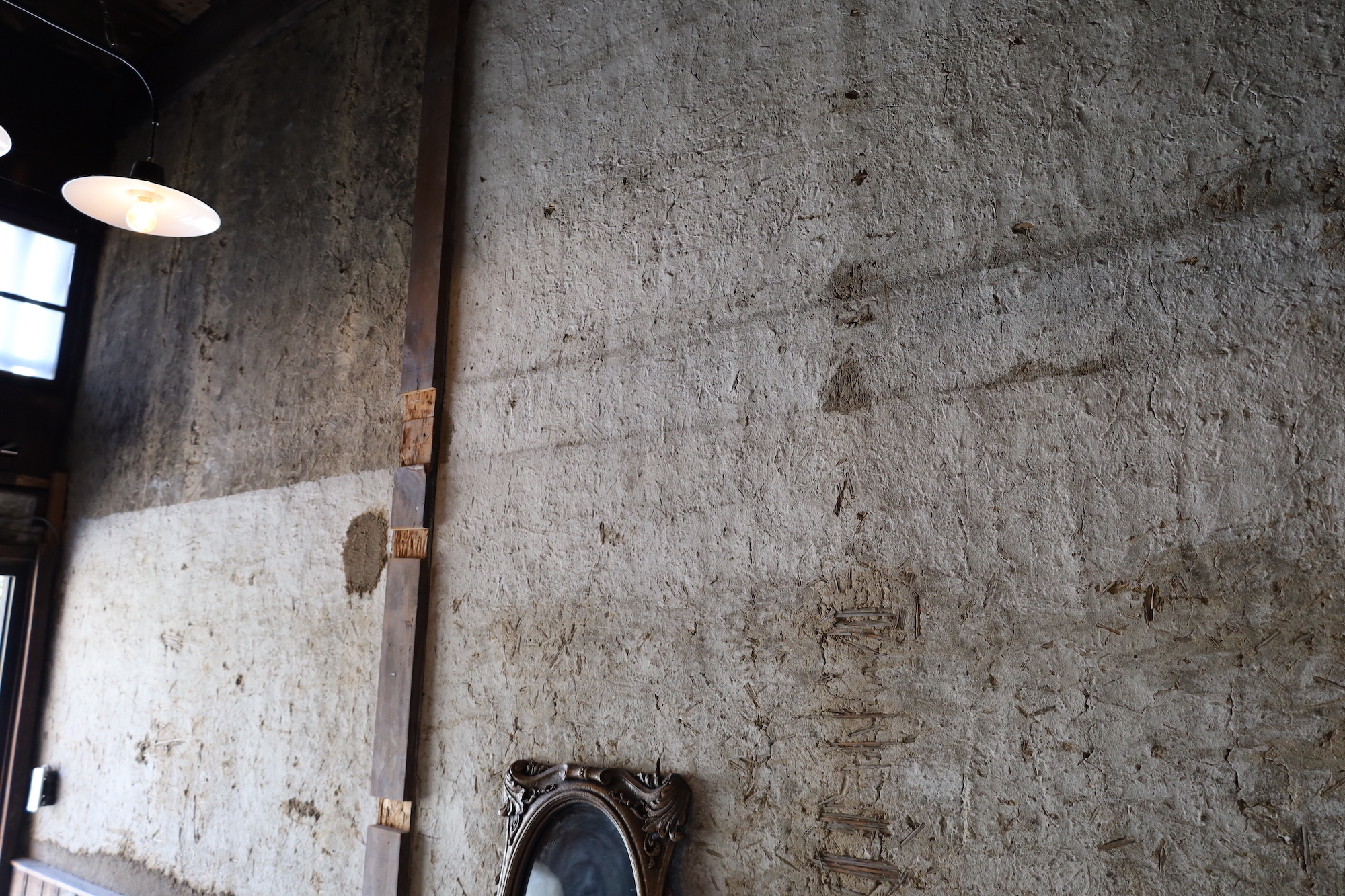
COTTLEのオフィシャルサイトに記述がありますが、アトリエの入口。
築年数が130年を越える建物には日本古来からの知恵が備わった”土壁”が存在します。
引き込まれるように目が止まり、思わず手で触れてみたくなるようなその質感。
期間中にお越し頂けた際には、実際に見てもらえると思います。
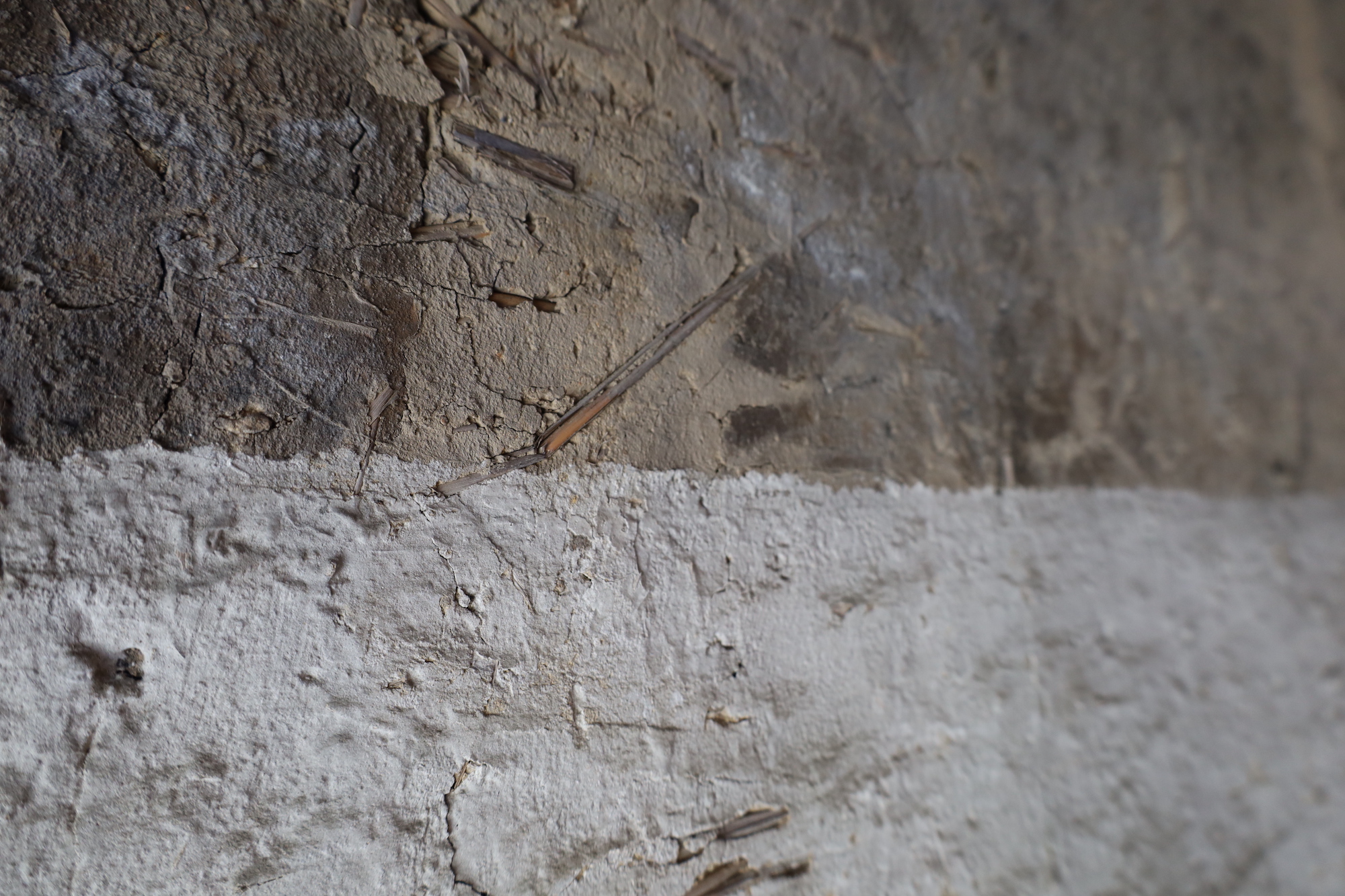
この土壁については、ブランドのオフィシャルページで、以下のように記載されています。
“土壁はその名の通りその土地の土を主な材料としていますが、土を発酵させて壁に膨らみを持たせる為に藁や基礎の強度と耐久性を持たせる為に竹を使用したり、場合によっては砂や鉄粉を混ぜることで営みに最適化したものとして用いられてきました。”
そこには先人の叡智が宿っており、今もなお、当時のままで見ることができることは、その技術力の高さを思い知ることができるものだと思います。
そして、その土壁からの深い考察のもと、COTTLEが開発をしたコレクション。
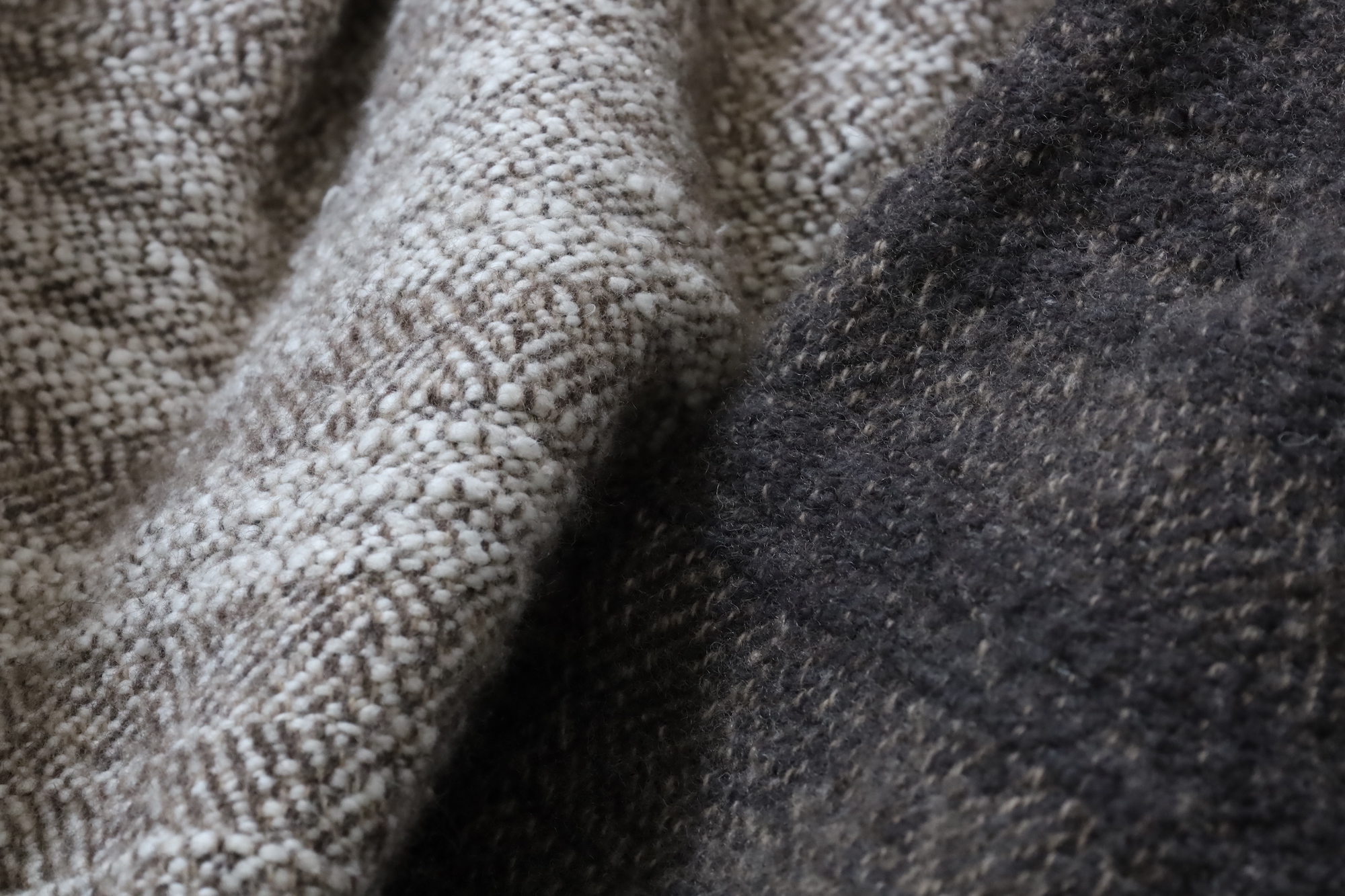
“EARTH WALL”
まるで手織りで出来上がった生地かのような生命力を感じる有機性。
この生地は、”工芸品”と、”工業製品”の掛け合わせと言える。
その2つ、どちらもの要素を持ち、それが半端じゃない程に高い領域で合致しているものだと思います。
これから記載をしていきますが、この”EARTH WALL”は、とても日本的な美しさを持っていることに加え、、、
着心地や、適した季節での着用時の暖かさ、身体への優しさという”高い性能”を持っています。
これこそまさに、使うための”用の美”を持った生地であり、“民藝の思想”が注がれた洋服コレクションであると思う。
ということで、この凄さをご覧頂ける皆様に知って頂きたいと思い、今回の記事では、こちらを紹介をさせて頂きます。

非常に複雑な織り組織で、この生地そのものに生命の動きを感じる。
手織り生地であると言われても、何も疑わないような見た目である。
それくらい、糸そのものに膨らみがあり、とても表情が豊かで、見入ってしまうほど。
混率は、
オーガニックコットン 57%
ウール 23%
カシミヤ 20%
というものであるが、COTTLEと、COTTLEに関わる職人、その”両者の魂”が注がれて完成しているもの。
混率では全く読み取れない”EARTH WALLだけの凄み”が確実に存在してる。
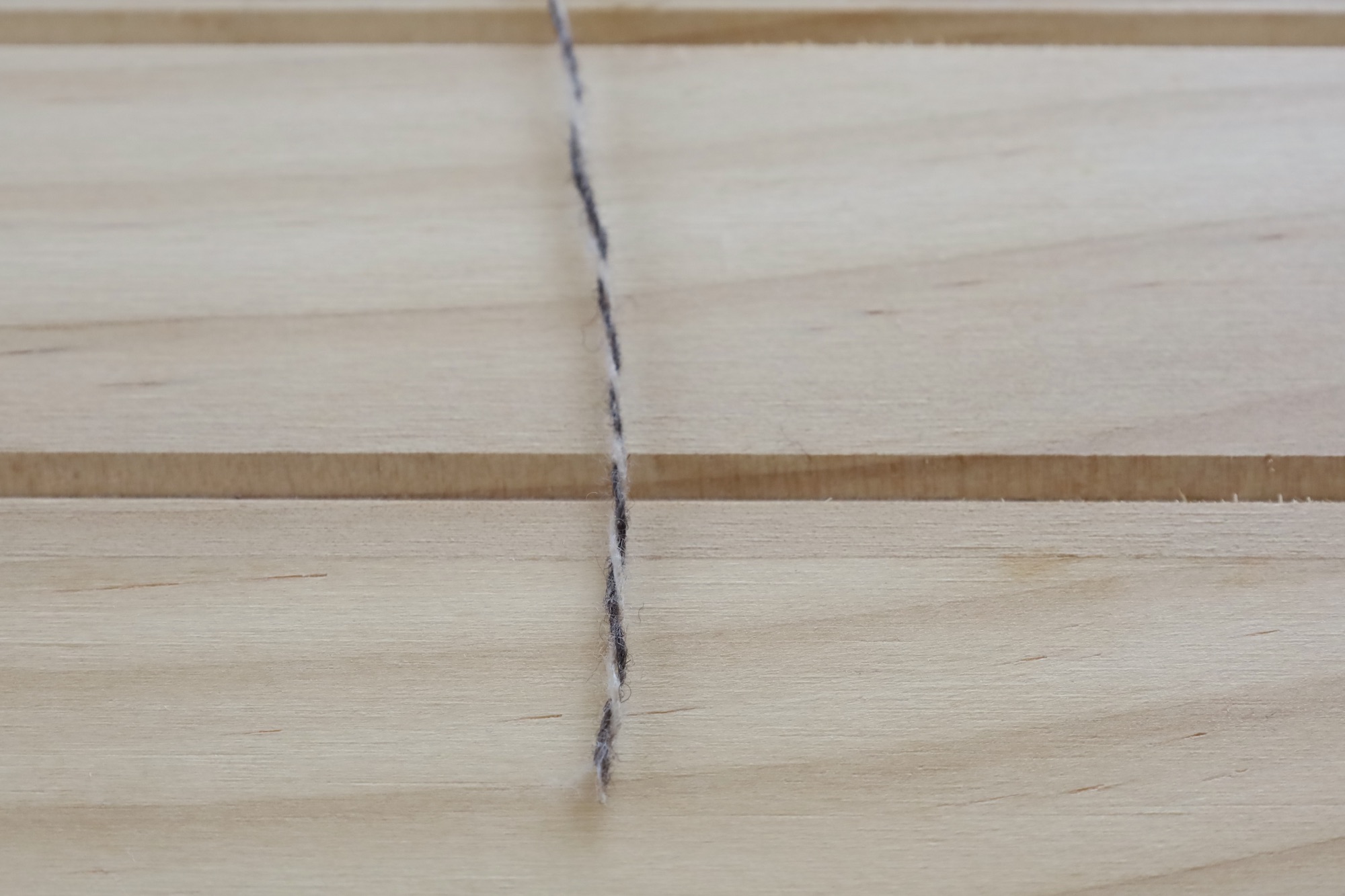
まず、これが経糸である。
ベージュとダークブラウンの2つの糸が合わさり双糸となっている。
このベージュが獣毛色そのままの無染色カシミヤ、16番手単糸。
対して、
ダークブラウンっぽい色合いが、オフィシャルページにも記述があるけど、”サルノコシカケ”から着想し、COTTLEのオリジナル色をつくったウール、14番手単糸である。
その単糸を撚り合わせ、双糸としたものを経糸にセットしています。
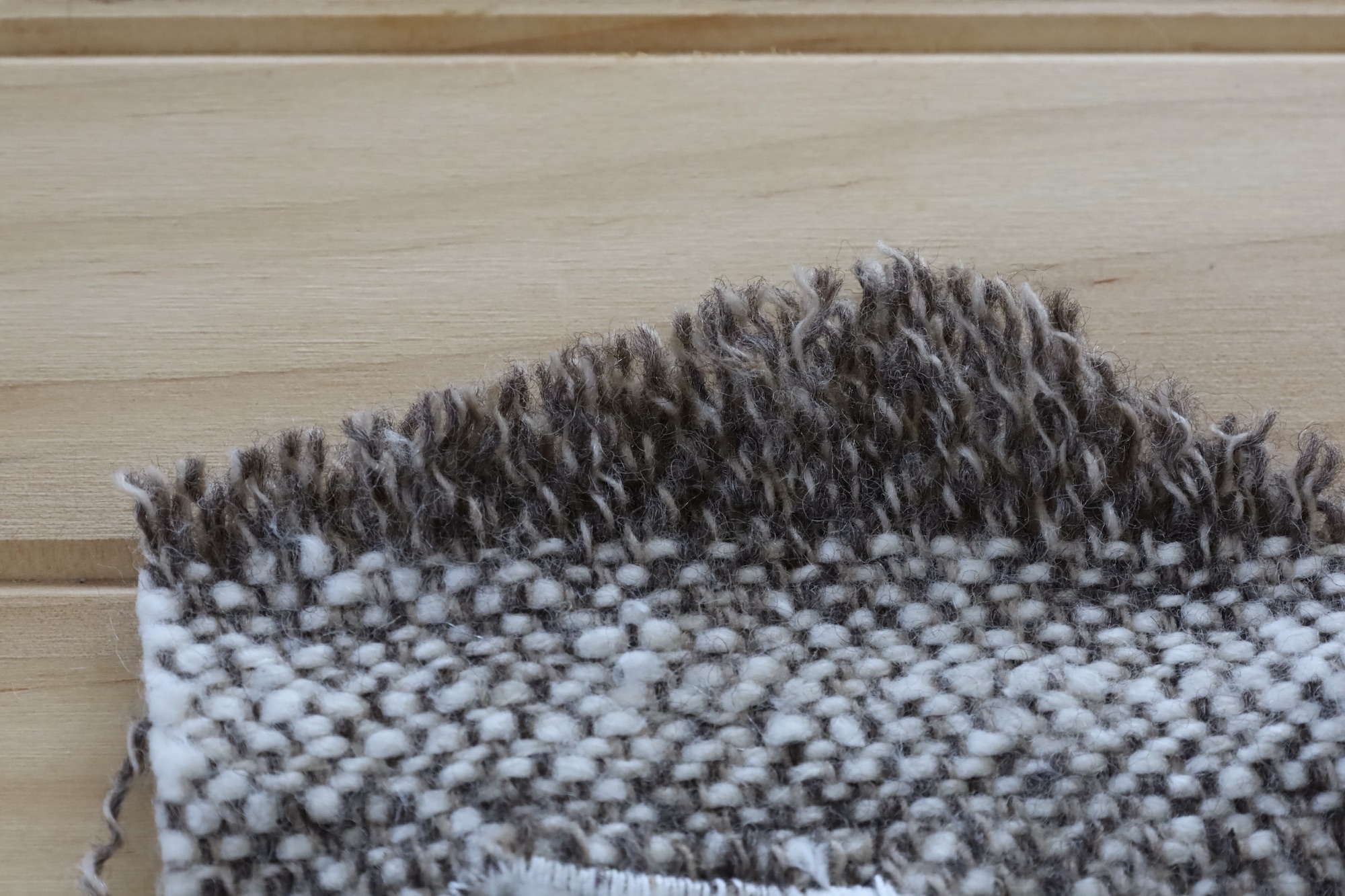
COTTLE渡辺さんからの好意により、EARTH WALLの生地を理解させてもらうために、一片を借りて撮影したもの。
カラーは、最もEARTH WALLのムードが分かりやすい”STUCCO ECRU”というもので撮っています。
上の写真の、経糸部分のウールカシミヤ双糸の部分にご注目頂きたいのですが、経糸本数が考えられていることと、非常に糸に膨らみがあるため、経糸箇所だけでも充分な密度が感じられる。
加えて、このような獣毛織物特有の、肌へのチクッとする感覚は皆無である。
僕の認識では、仮に、カシミヤ100%であったとしても、”織物”とする場合には、ニットと違って、糸や織り、加工で工夫をしないと、必ずチクチクしてしまうというイメージなのですが、COTTLEの経糸は、全く心配する必要はありません。
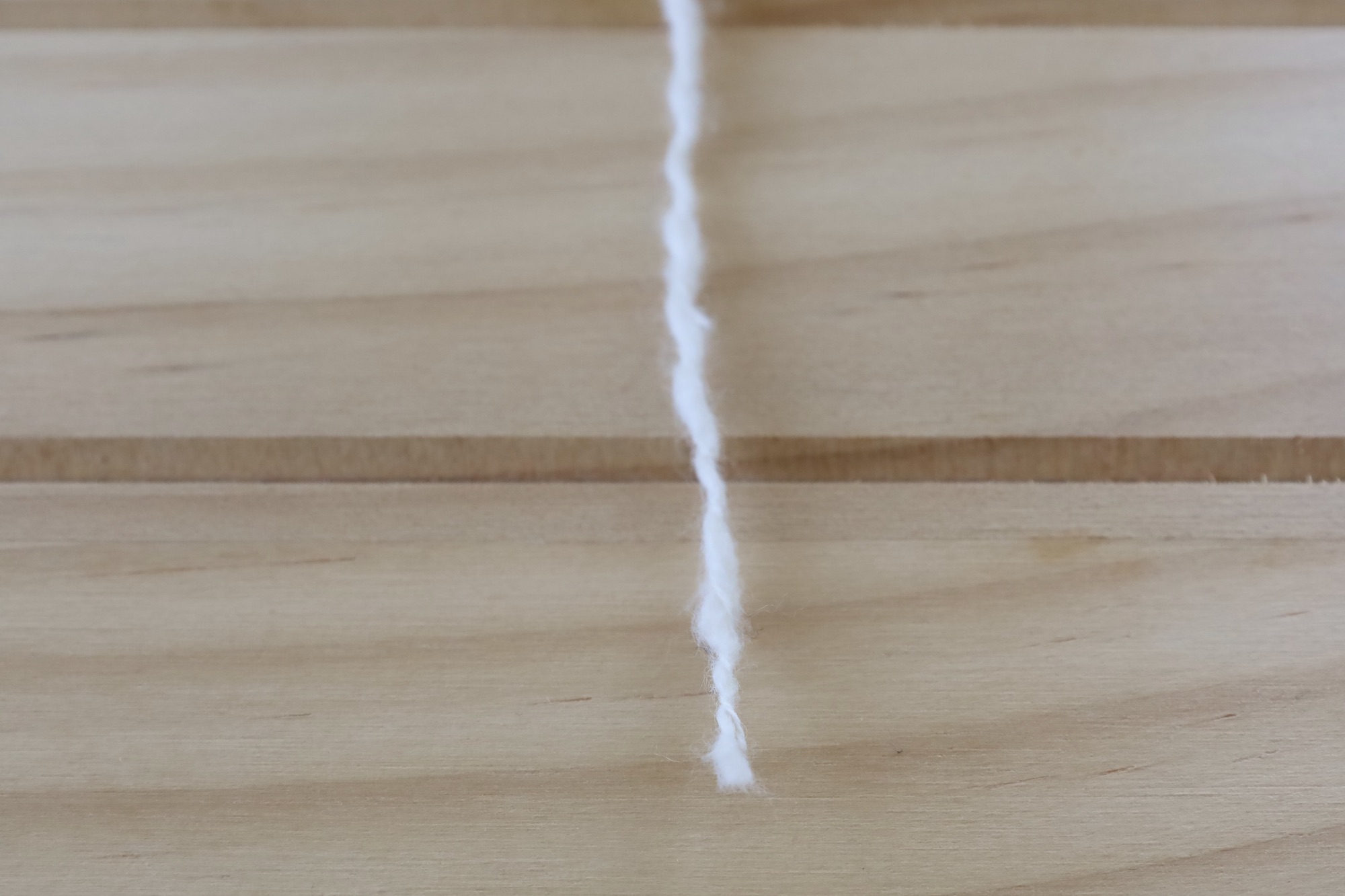
次に、緯糸。
緯糸がコットンであるが、このコットン糸がただものではない。
“ガラ紡”というものである。
明治時代に日本で発明された紡績方法だそうで、他の紡績技術と比べると独創的なもの。
コットンの紡績方法は、アメリカやイギリスで考案されたものがいくつかあり、それが現代でも主流。
ガラ紡でつくられる綿糸は、工業的で均一的な糸の表情とは、大きく異なり、COTTLEの考える美しい”手仕事”と、とても趣のある糸の様子である。
一本の綿糸の中で、膨らみ方や締まり方に変化があり、その糸の太さが変わる中で、ガラ紡で紡績されるスピードも、早くなったり遅くなったり。
更には、ガラ紡で紡績をされる途中で、糸が途切れてしまった際には、手で紙縒る(こよる)かのようにして繋いでいく作業が必要となるそうだ。
この”ガラ紡”をCOTTLEでは、ブランド初期から研究を続け、発展を遂げたものをEARTH WALLで使っているというもの。
綿繊維が持つ、そのままの膨らみと、肌触りを最大に感じられる糸の風合いは、文字通り、”昔ながらの手仕事のものづくり”の高い品質をすごく感じることができる糸。
ただ、”ガラ紡だけでは、織機に入れることができない”という、他の紡績では考えられない側面があるため、その糸に、壁糸という細い綿糸を巻き付け、織機で織り上げることができるようにしているというもの。
僕自身、過去にスヴィンゴールドシュプリームやアルティメイトピマをはじめ、いろいろな綿繊維を追い求めてきた方ではありますが、ガラ紡糸の風合い、質感に触れた際には、他では比較ができないほどの極めてエアリーで良質な糸に驚きました。
もちろん、目指すベクトルにもよるとは思いますが、そのような糸がCOTTLE以外では出会うことがなかった理由が、上記のようなこと。
手がかかり、織物にするためには工程数も多く、とても高価なコットン糸ではありますが、その糸の美しさと、とても柔らかい風合いは、本当に変え難いものがあると思います。
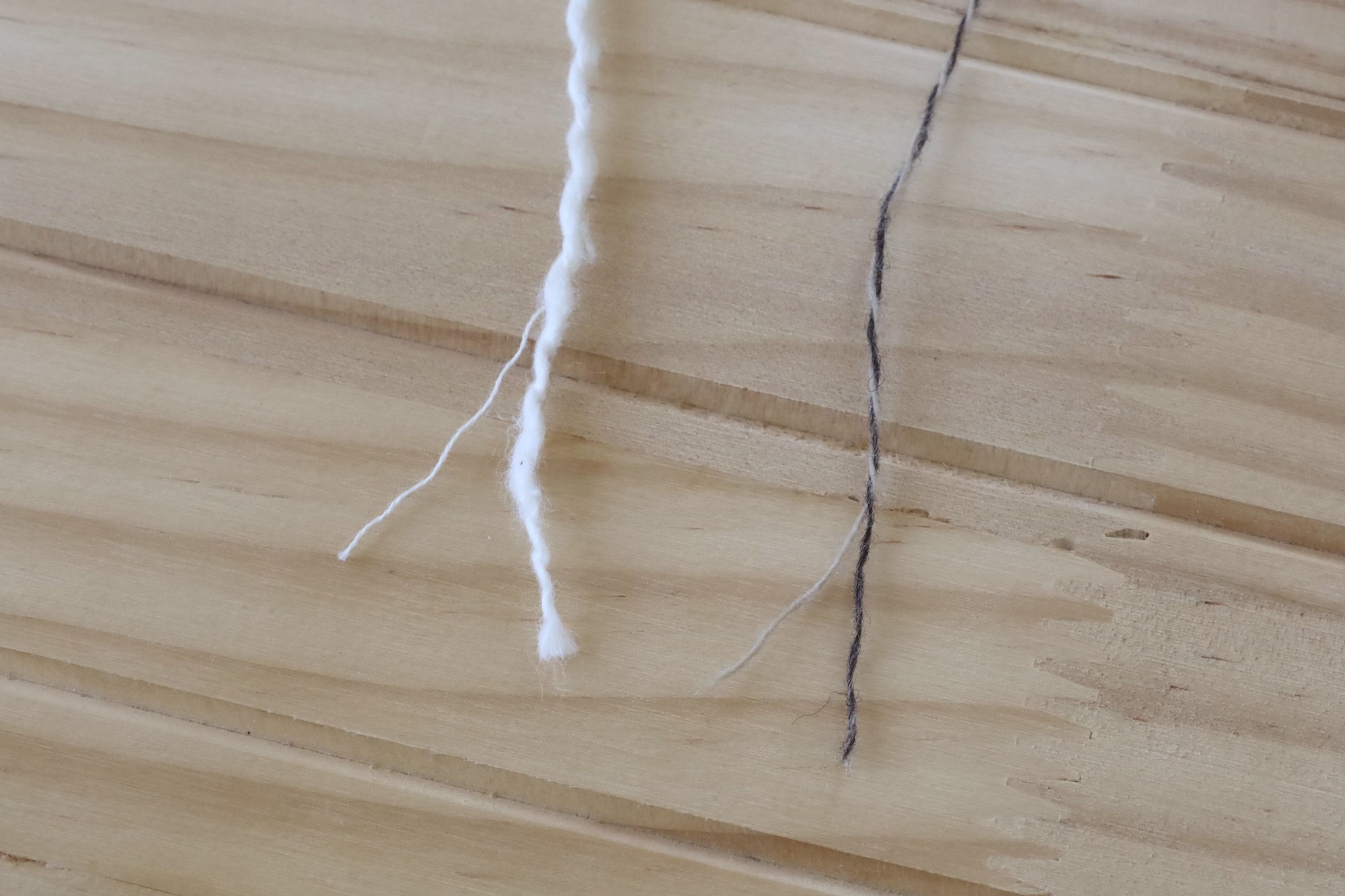
表情も性質も、全く異なる経糸と緯糸。
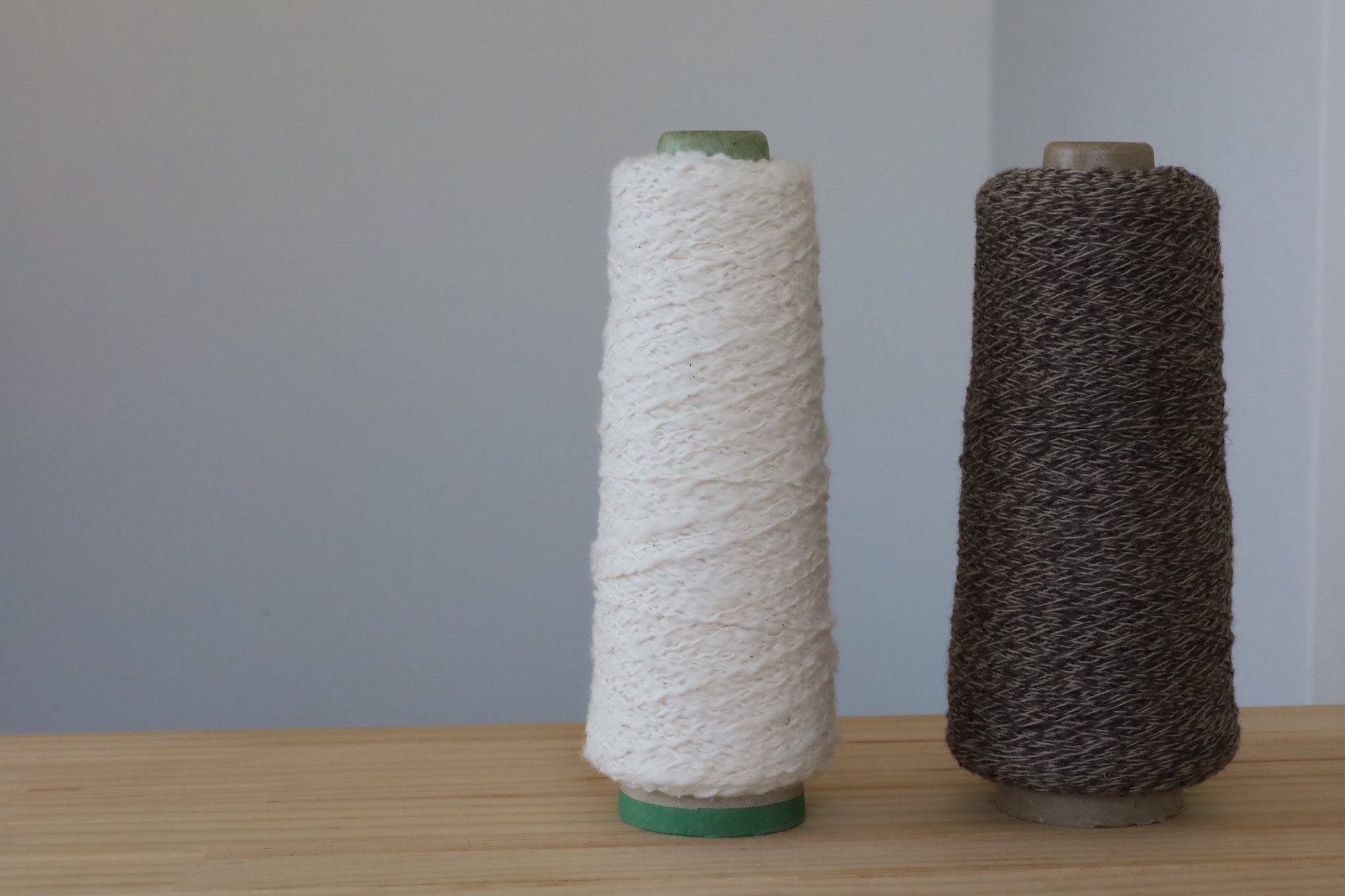
上記のような糸で織り上げられる”EARTH WALL”。

黒やグレー、ブラウン、無染色の獣毛色と、ダークトーンの中で色相の異なる”SOIL BROWN”。
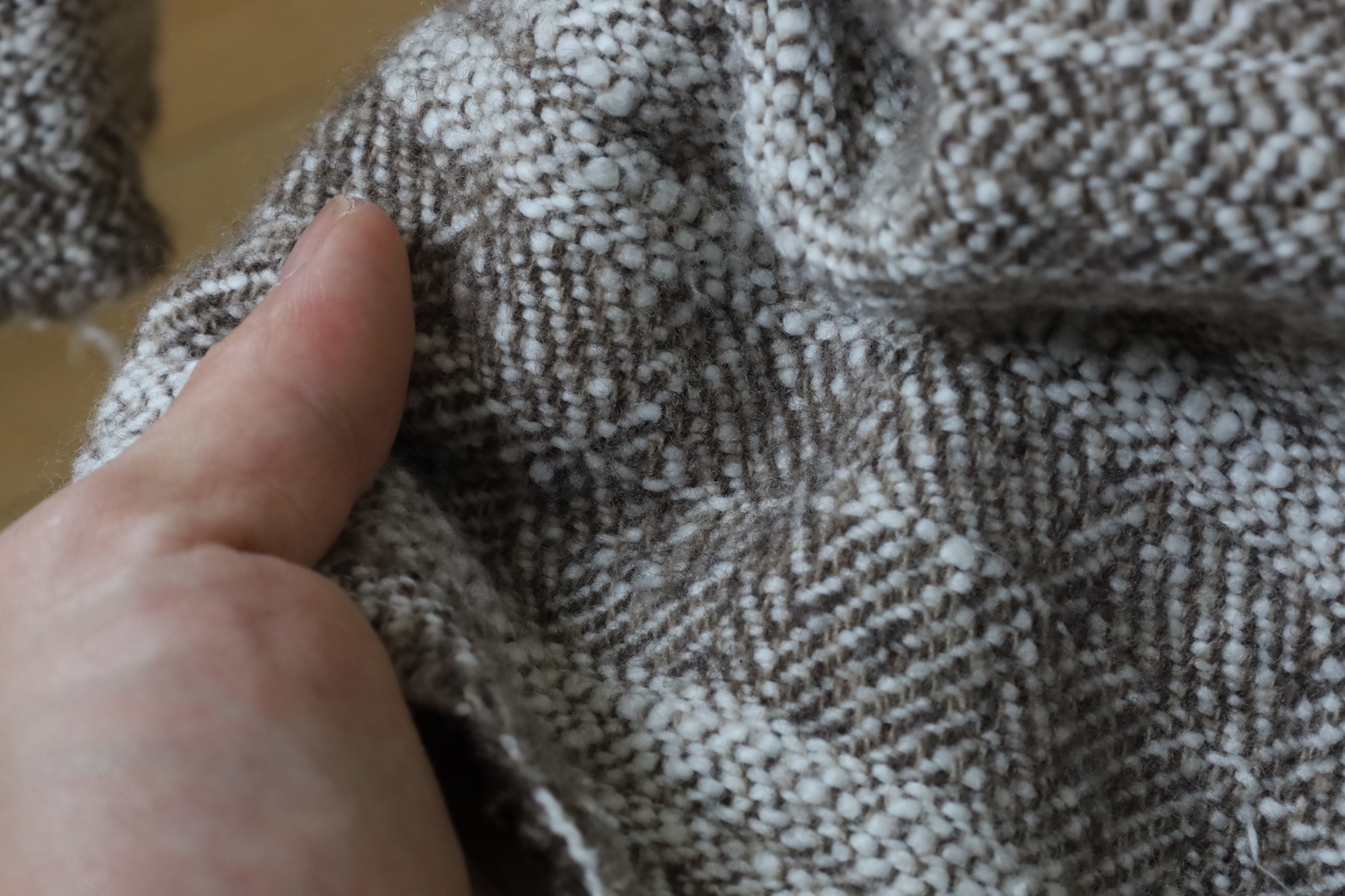
先ほどから紹介している”STUCCO ECRU”。
“土壁”のように、ふと目に止まり、触れてみたいと思わせるほどの、感性にアプローチする生地。
そして、実物でそれを感じてみて頂けたらと思う。
のですが、、、
僕がこの生地に驚いた理由。
それは、まだここから。
冒頭に記載をしたように、“用の美”を持った生地であるということ。
そのことを、ここから僕なりに紹介します。
まず、EARTH WALLの洋服は、ほとんどのものが”裏地がつきません”。
生地感からして、季節で考えると秋冬の時期が適正であるのにも関わらず、ほぼ一重仕様です。
コレクションでは、パンツも存在しますが、パンツさえも、裏地なしの一重です。
ただ、これまでEARTH WALLのパンツを愛用する方々からは、「一重なのに、冷たい風が入らず、暖かいし、とても快適に過ごせる。」ということを何度も耳にしてきました。
想像頂ければと思いますが、通常、太い糸で織り上げられている生地は、糸と糸の隙間が大きく、暖かみのある見た目でありながらも、実は”風が通り抜けてしまい寒い”という、大変残念な事象が起こることがあると思います。
はたまた、少し毛羽立ちがあるようなウールや、獣毛系の織り生地は、やはり着用時にチクチクとした肌への不快感があることがあると思います。
しかしながら、このCOTTLEのEARTH WALLは、”すごい領域”を実現してる。

ガラ紡を使うことで非常にエアリー。
そして、生地洗いと、製品洗いのどちらもを行なうことで、素材の膨らみが存分に生まれるというもの。
だから、非常に軽く、着用時には柔らかく身体に乗る感覚がある。
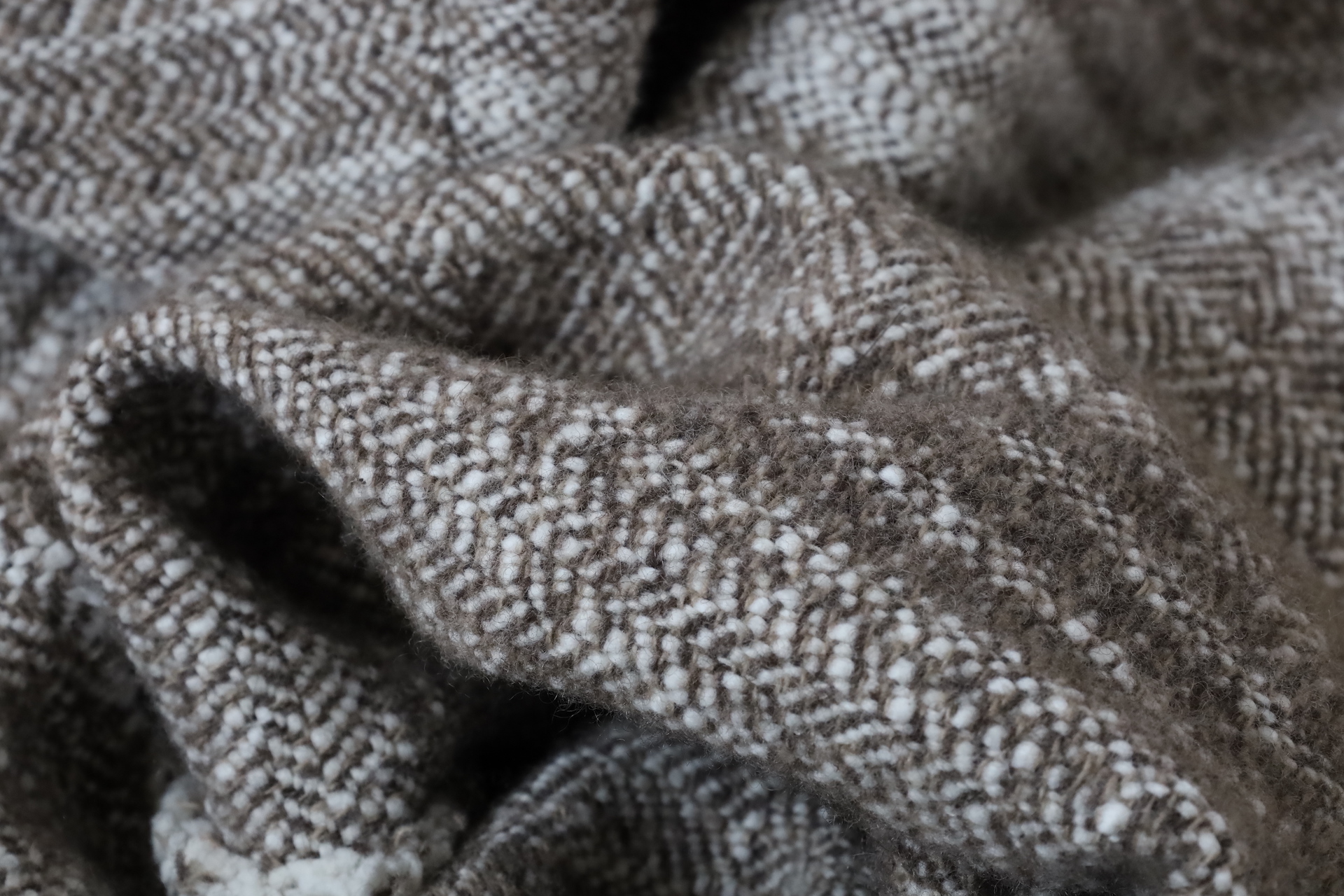
こちらの写真は、裏の肌に当たる側の写真ですが、裏地がないことで、柔らかな素材の膨らみが身体を自然に包み込む。
表には、ガラ紡が多く現れ、生地表面の豊かな表情による凹凸と、たっぷりと空気を含んで、暖かな層をつくる。
裏側には、ウールとカシミヤのふんわりと、心地良い繊維特性が思う存分に現れる。
更に、こちら。
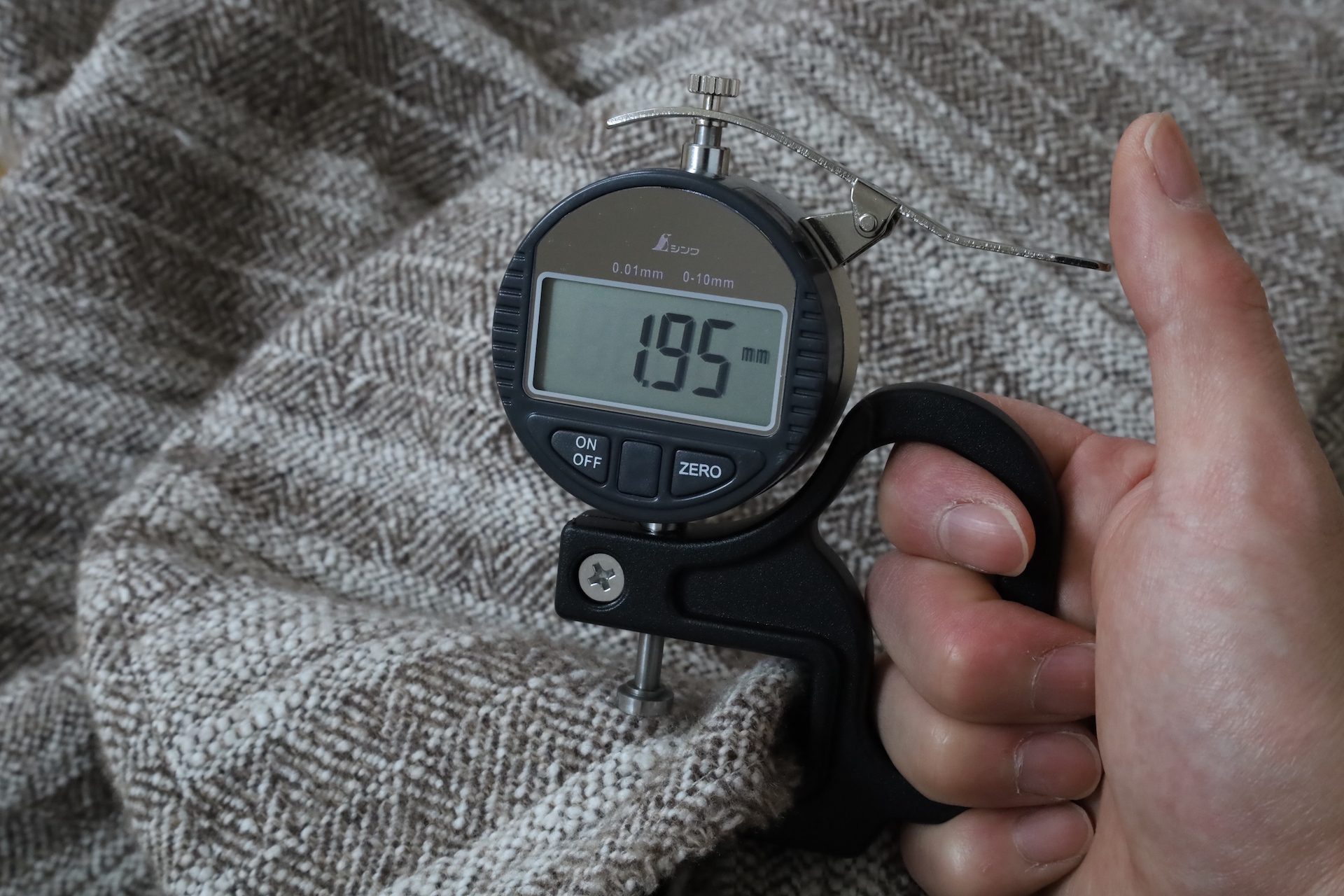
数年前、カネタ織物さんに教えてもらった生地の厚みを見るための測定器。
EARTH WALLの生地、1.95ミリである。
こちらは、緯糸のガラ紡が細い箇所の計測値で、、、

緯糸の太い箇所での計測値は、2.68ミリというもの。
この数値は、非常に驚異的である。
通常、メルトンやツイードなどのガッチリとした冬の厚みのある生地でも、その厚みは、1.1ミリ前後である。
また、COTTLEの他のコレクションをお持ち頂いている方は、”LEAF VEIN”の生地が通常のシャツ生地と比べて厚みがあるのをご存知だと思います。
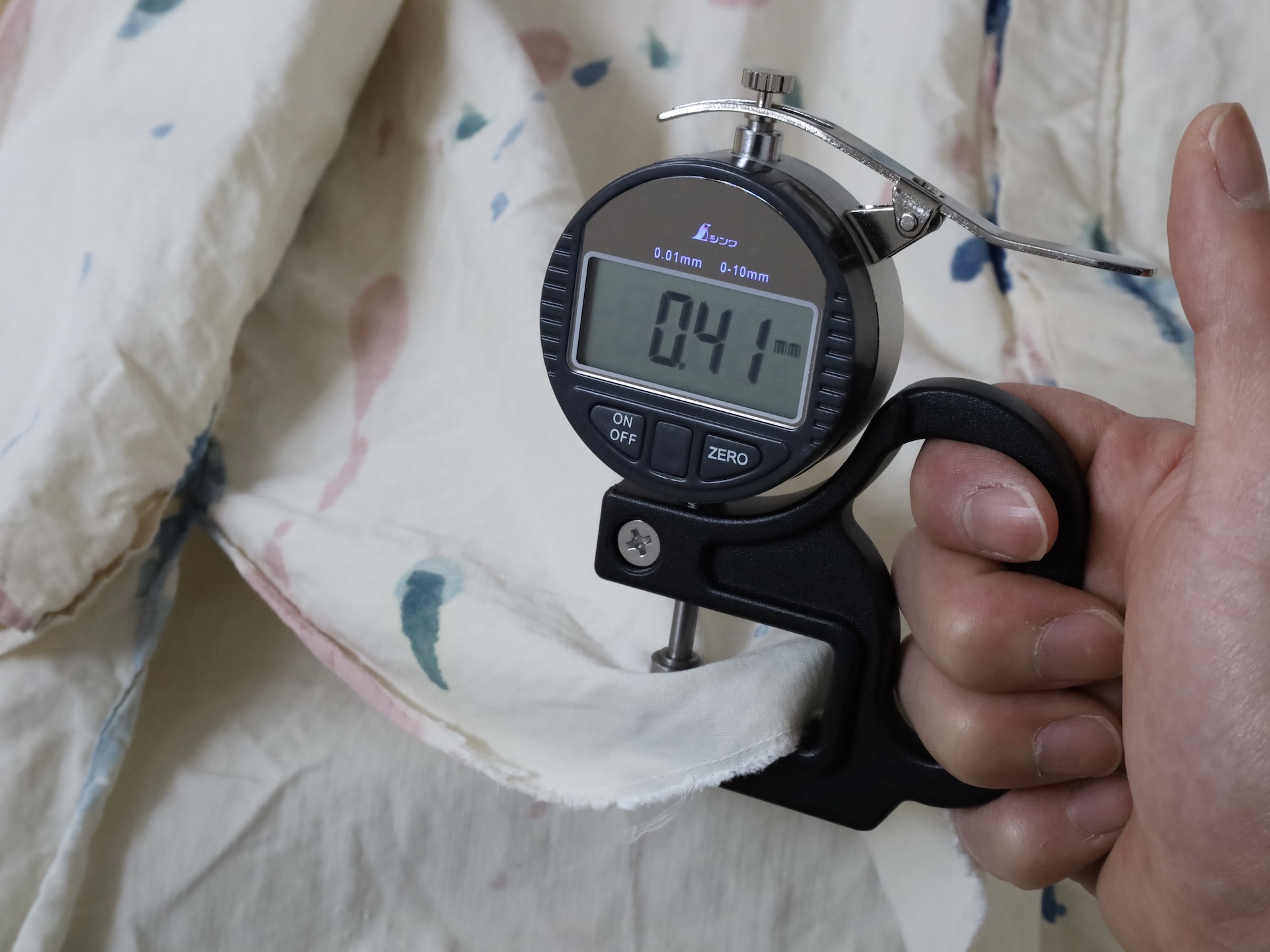
LEAF VEINの生地は、0.41ミリ。
この厚みは、シャツ生地と秋冬ジャケット生地との中間的な厚みである。
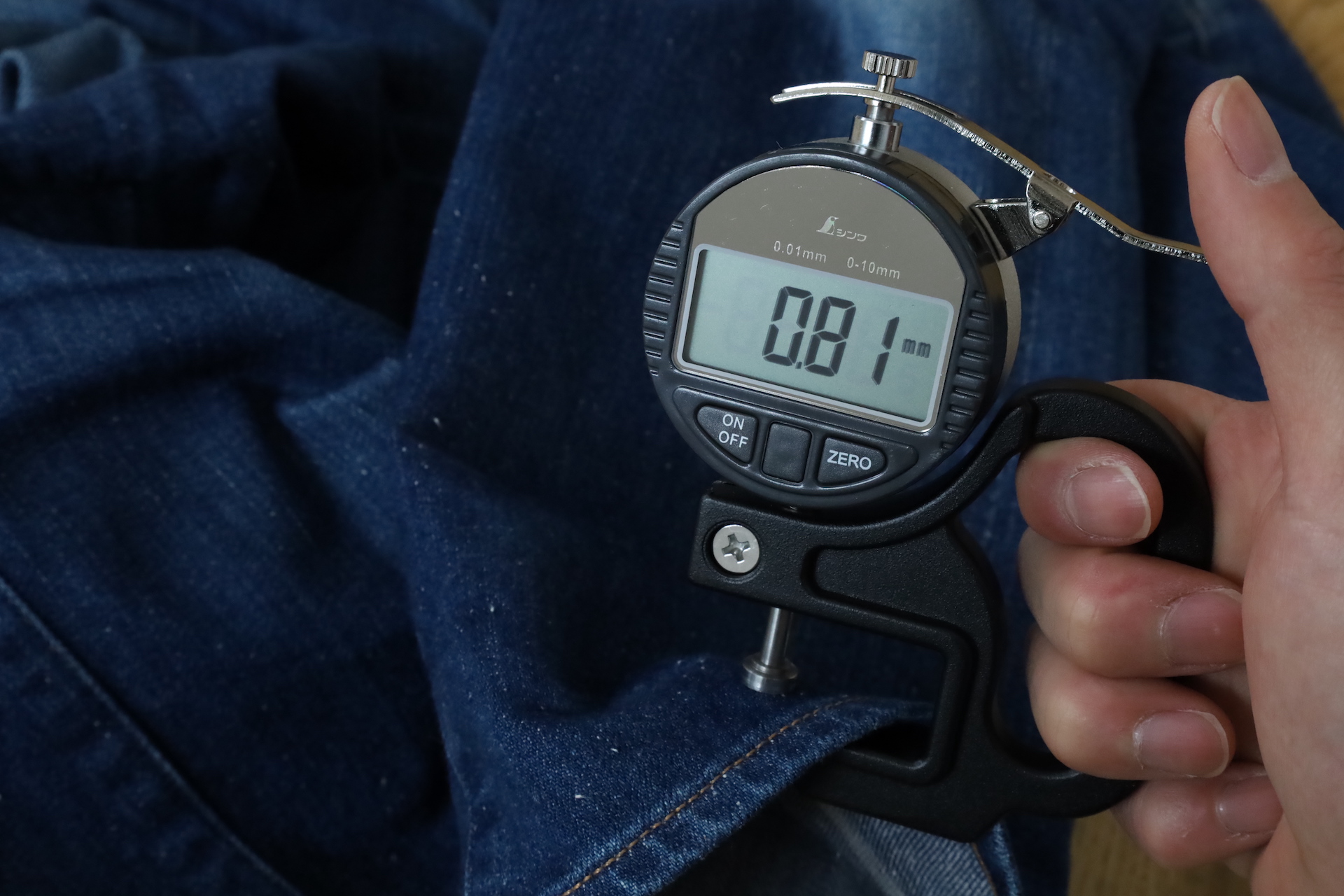
また、COTTLEの11.3ozデニムは、0.81ミリ。
通常は、11oz前後となると、厚みは0.65ミリ辺りが一般データだそうですが、糸がふっくらとした生地であり、一般的な数値よりも膨らみがあることが分かる。
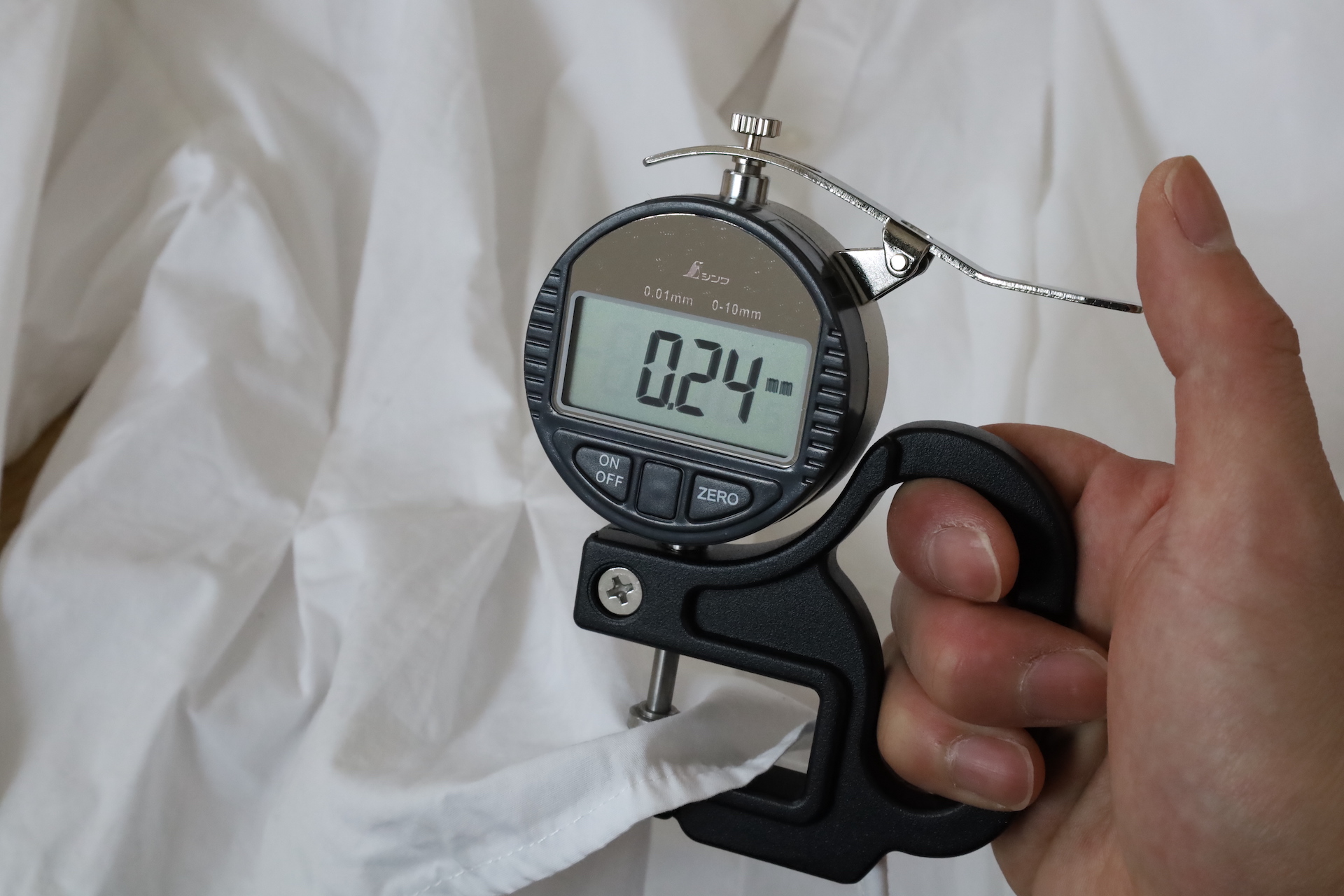
比較のために、僕の妻のシャツを計測すると0.24ミリ。。。
一般的な量産型の綿100%のシャツ生地ですが、全然違う結果です。
ちなみに紙幣は、0.1ミリ前後になるようにつくられているそう。
以上のことから、COTTLEの生地は糸の膨らみが強く、しっかりとした生地の厚みがあることが分かる。
中でも、EARTH WALLは、一般的な工業的につくられたメルトンと比べても、倍以上の数値となります。
また、生地の厚みだけではなく、、、
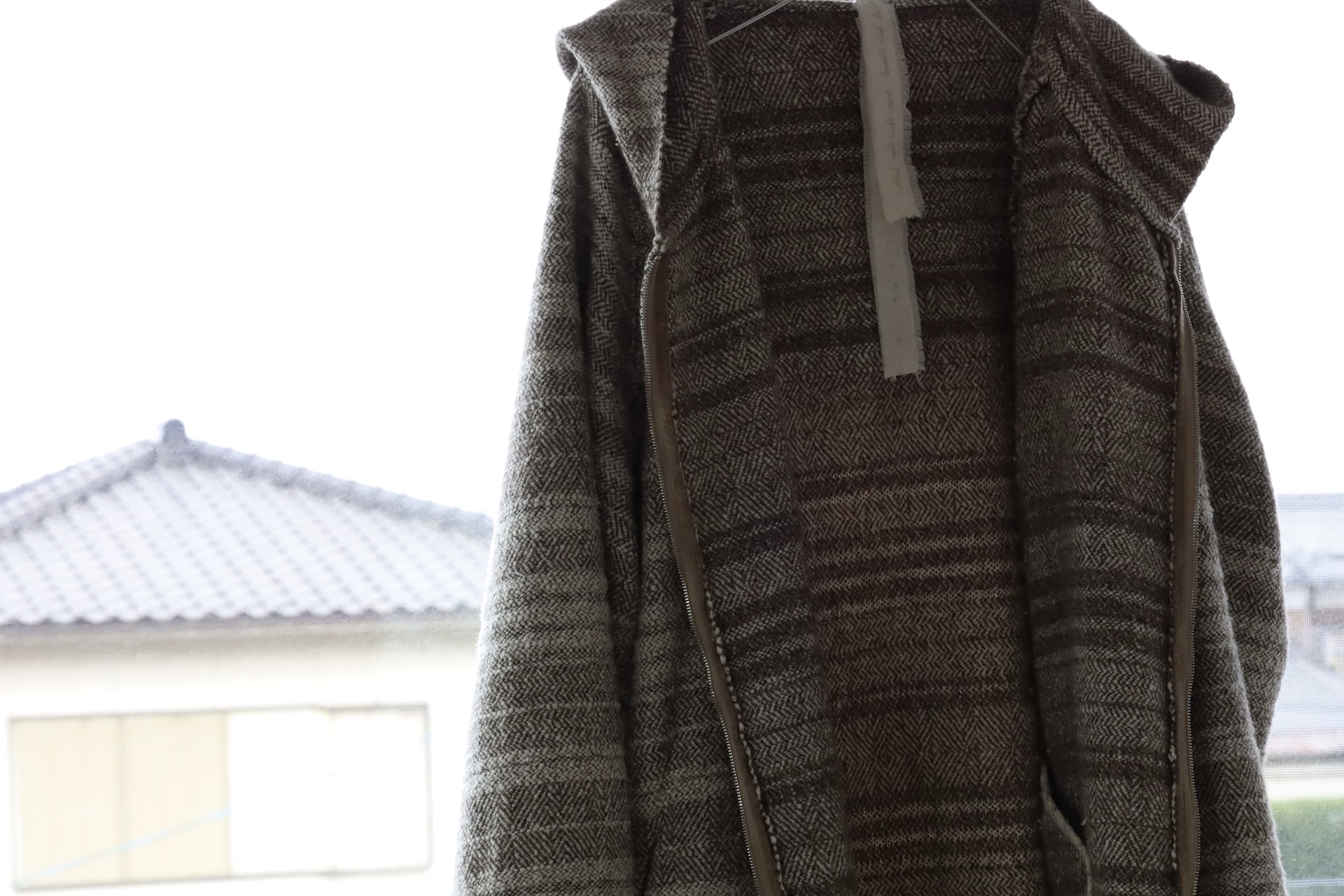
裏側から生地の密度を見るために、自然光を当てて撮影。
無人駅が最寄りの田舎の風景が写ってる。
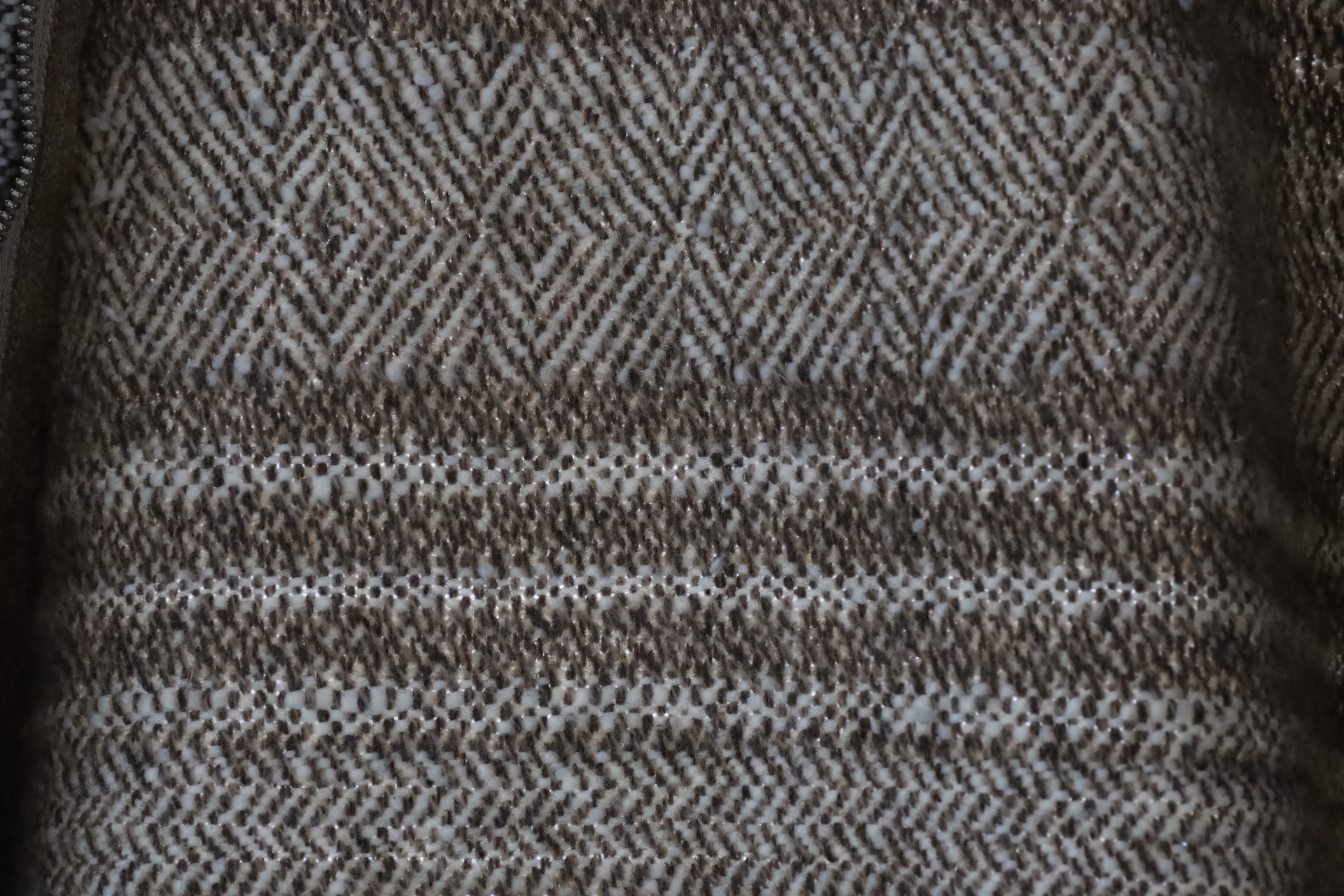
このように自然光で透かすと、、、光が抜ける様子が非常に少なく、小さいことが分かります。
太い糸で織られている生地は当然ですが、そうではない生地でも、通常ならばもっと光が抜ける隙間が大きく、数も多いのが事実です。
意図して隙間を大きくつくった生地は例外ですが、量産的な生地であればあるほど、そのようになる。
また、安価な生地にはムラがあり、光の抜け方が不均一になるものも多いです。
このように、EARTH WALLの生地は、しっかりと密度があり、キメが整っているため、冷たい風が抜ける心配がなく、加えて、丈夫さも兼ね備えている。
ガラ紡の太い糸をしていても、これほど糸と糸の隙間が小さく、整っていることは類稀なことだと思います。
これだけの”生地厚”と”密度”を誇るEARTH WALL。
ただ、そのような生地厚でも、密度でも、
“非常にしなやかで、柔らかく身体に寄り添う生地”である。
そのため、一重の洋服はもちろん、裏地付きのジャケットであっても、着用時のフォルムが不恰好になってしまうことがありません。
フツーなら、2ミリ以上の厚みと、高い密度である生地ならば、硬くなり、着用時に分厚く、フォルムがボコッと膨らみ過ぎることが考えられますが、COTTLEでは、そのようなことはありません。
着用時にどう見えるのかということも、とても重要な項目として考えられています。
また、EARTH WALLの生地の着心地は、例えるならば、”思わず声が漏れるような、とっっっても柔らかく寄り添うブランケットを纏っている感覚”が実際と近いのではないかと思います。

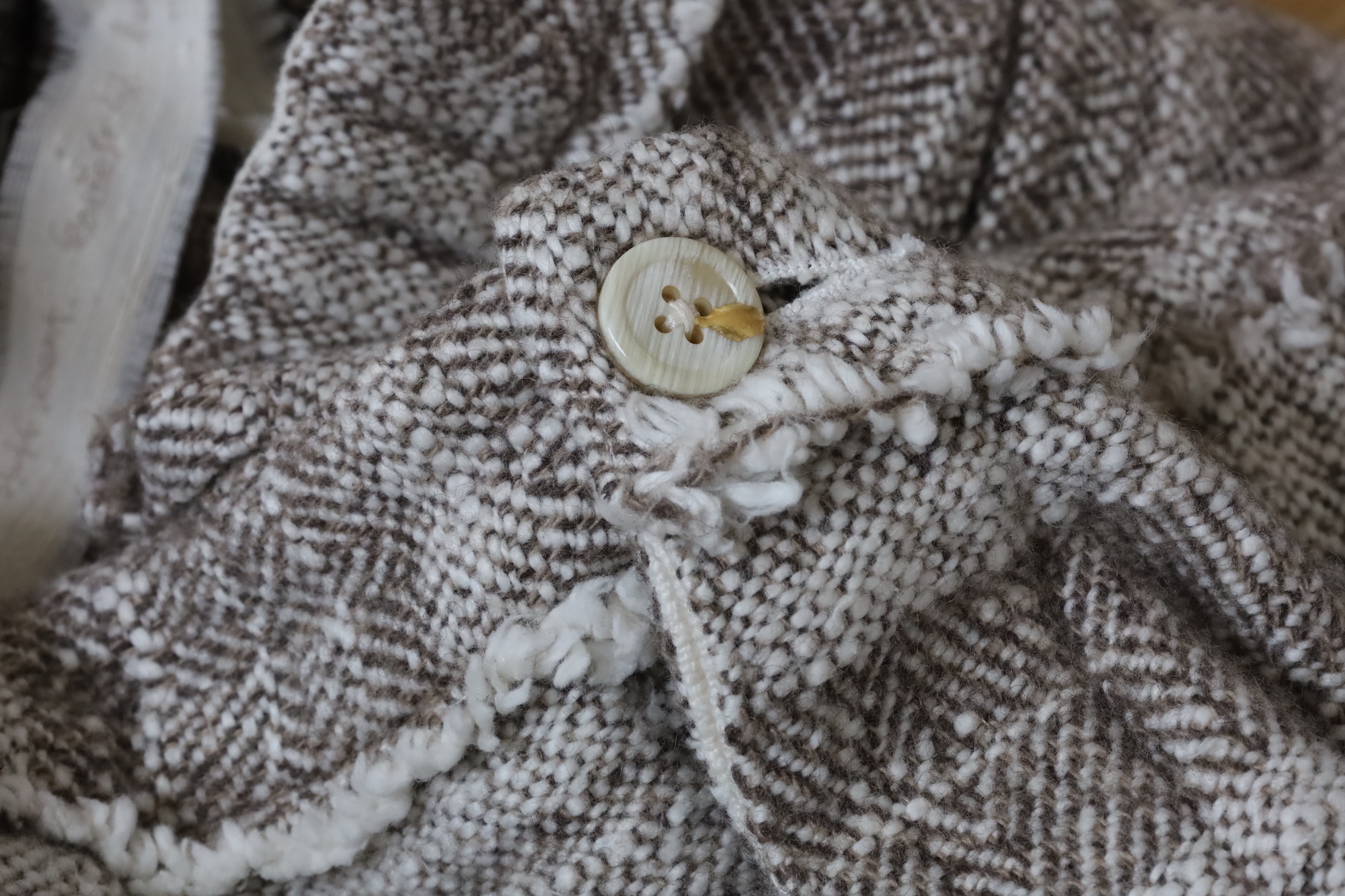
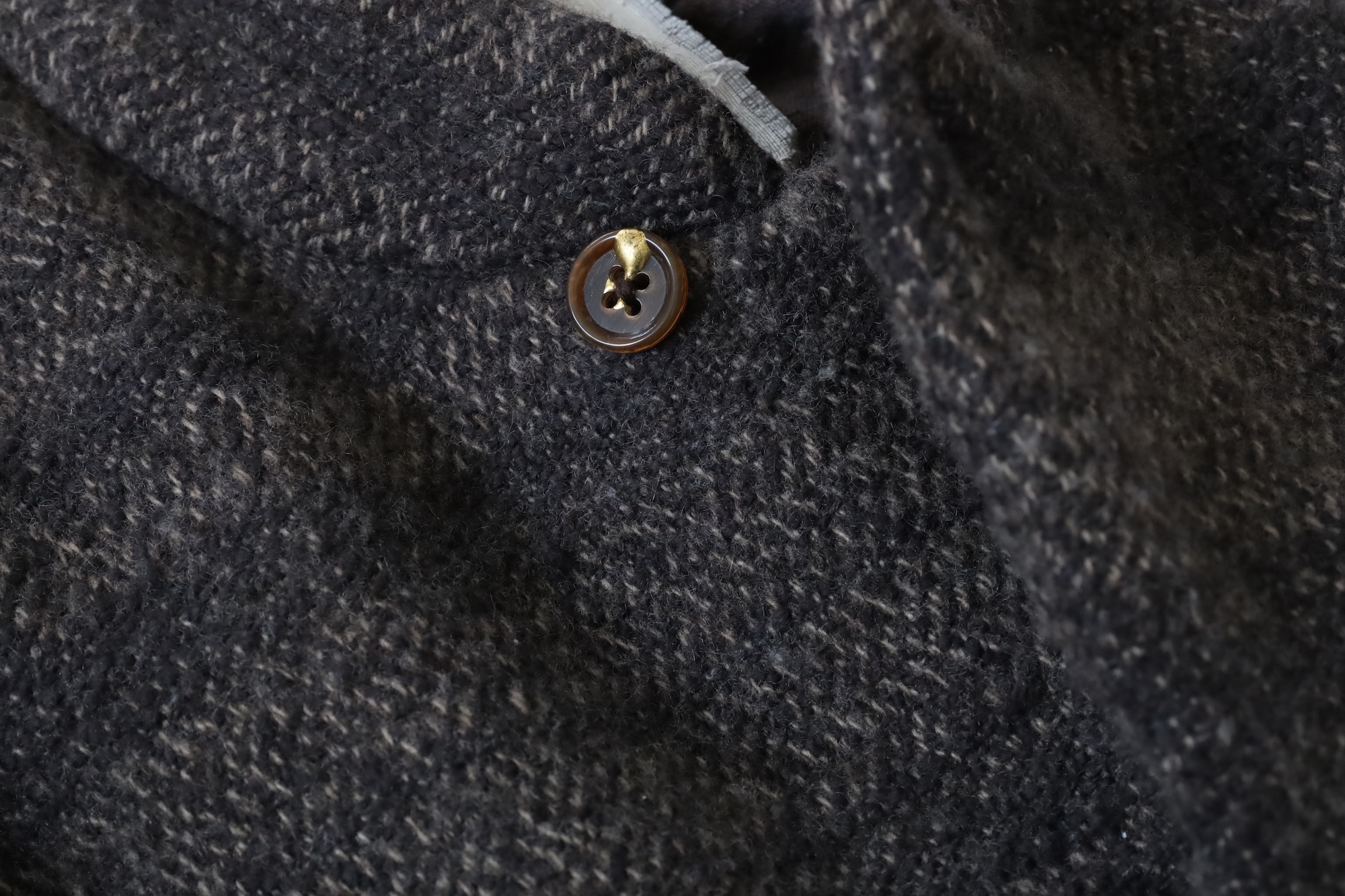
ブランドの思想が込められた”金継ぎ”ボタン。

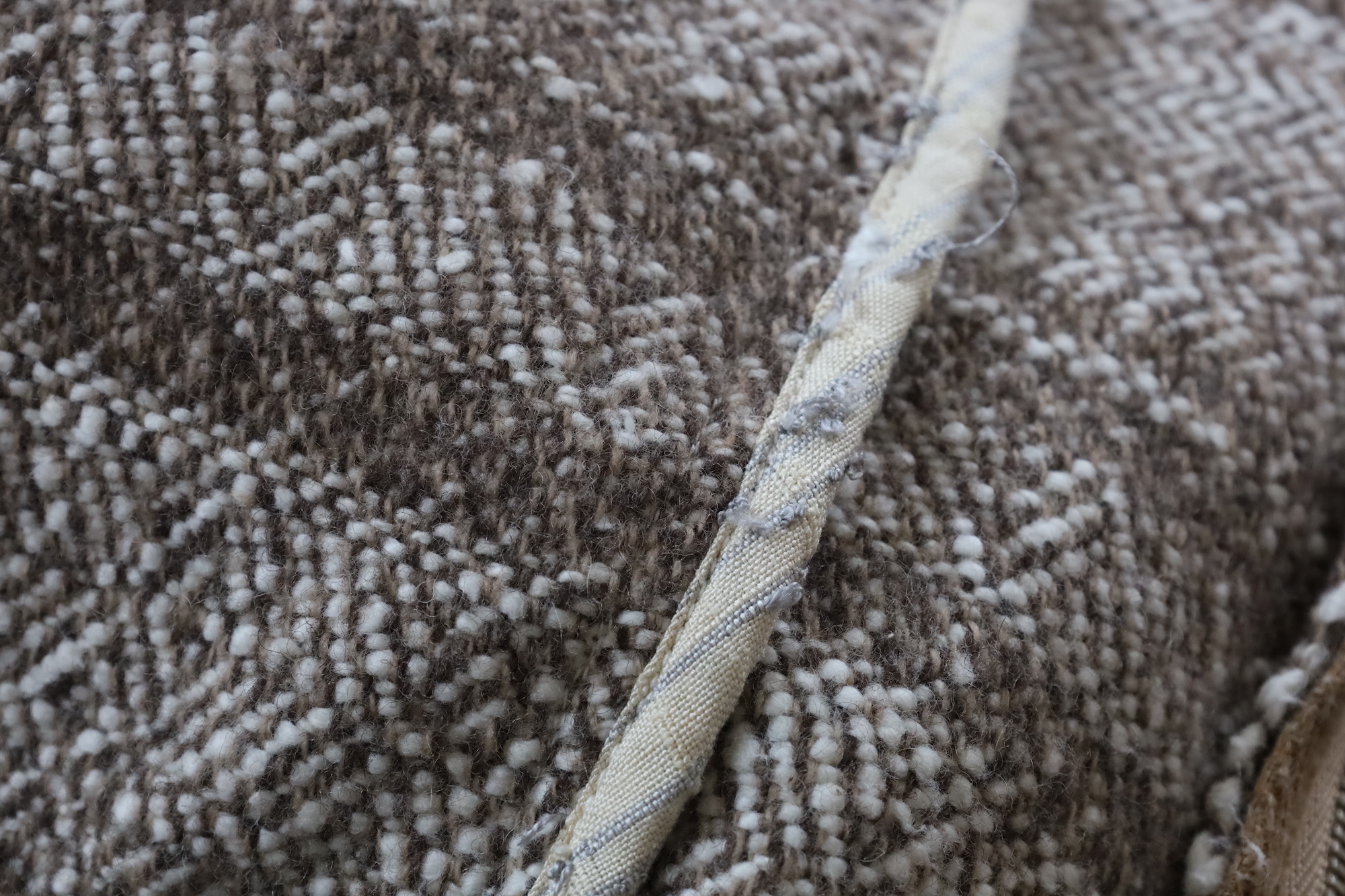
内側のポケット袋布端の処理には、”ヒゲつむぎ”が使われるものも。
COTTLEの洋服は、アトリエの自社縫製工場で一着一着生産をされるため、表はもちろん、内側のディテールも、縫製仕様も非常に手が入れられています。
以下にいくつかモデルを紹介します。
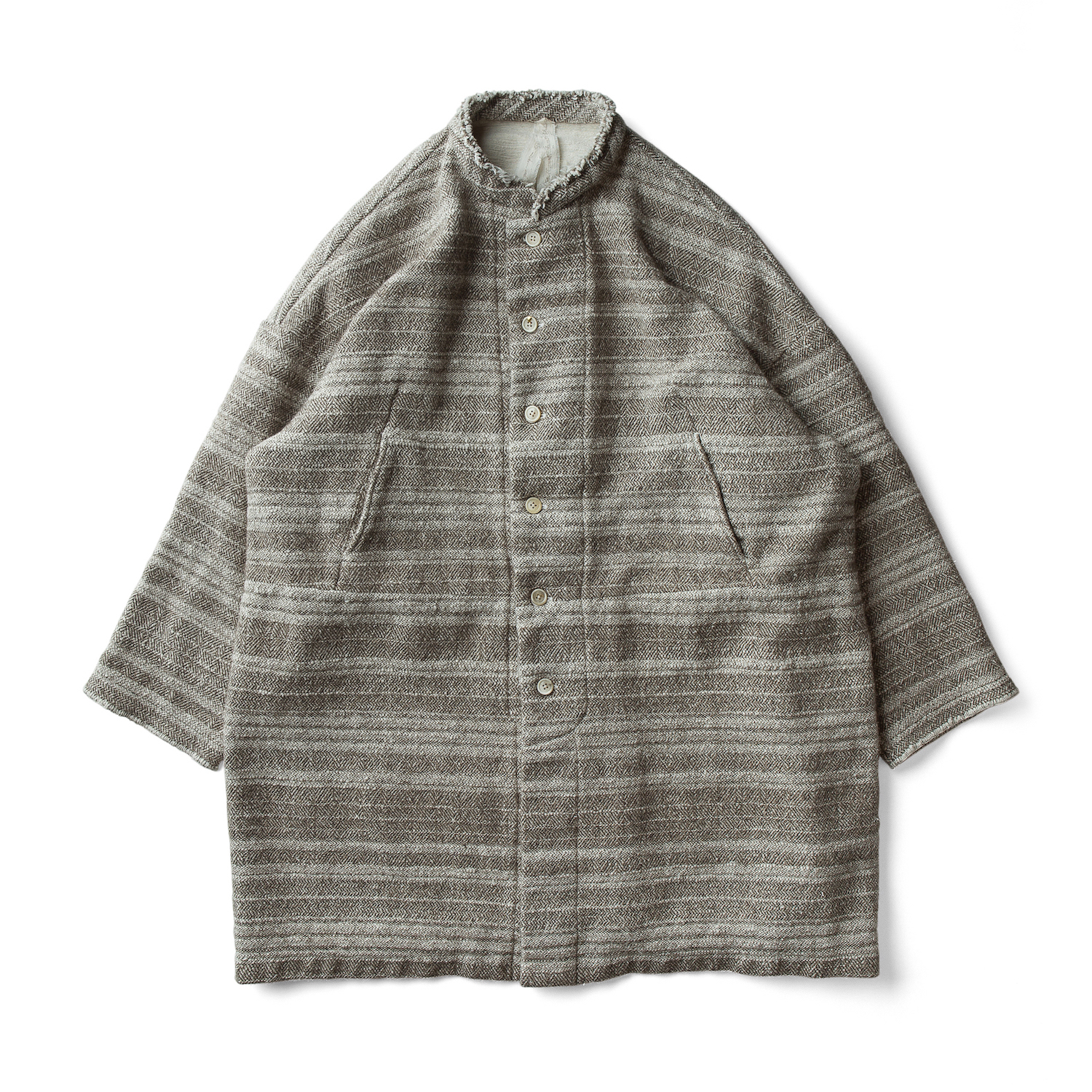
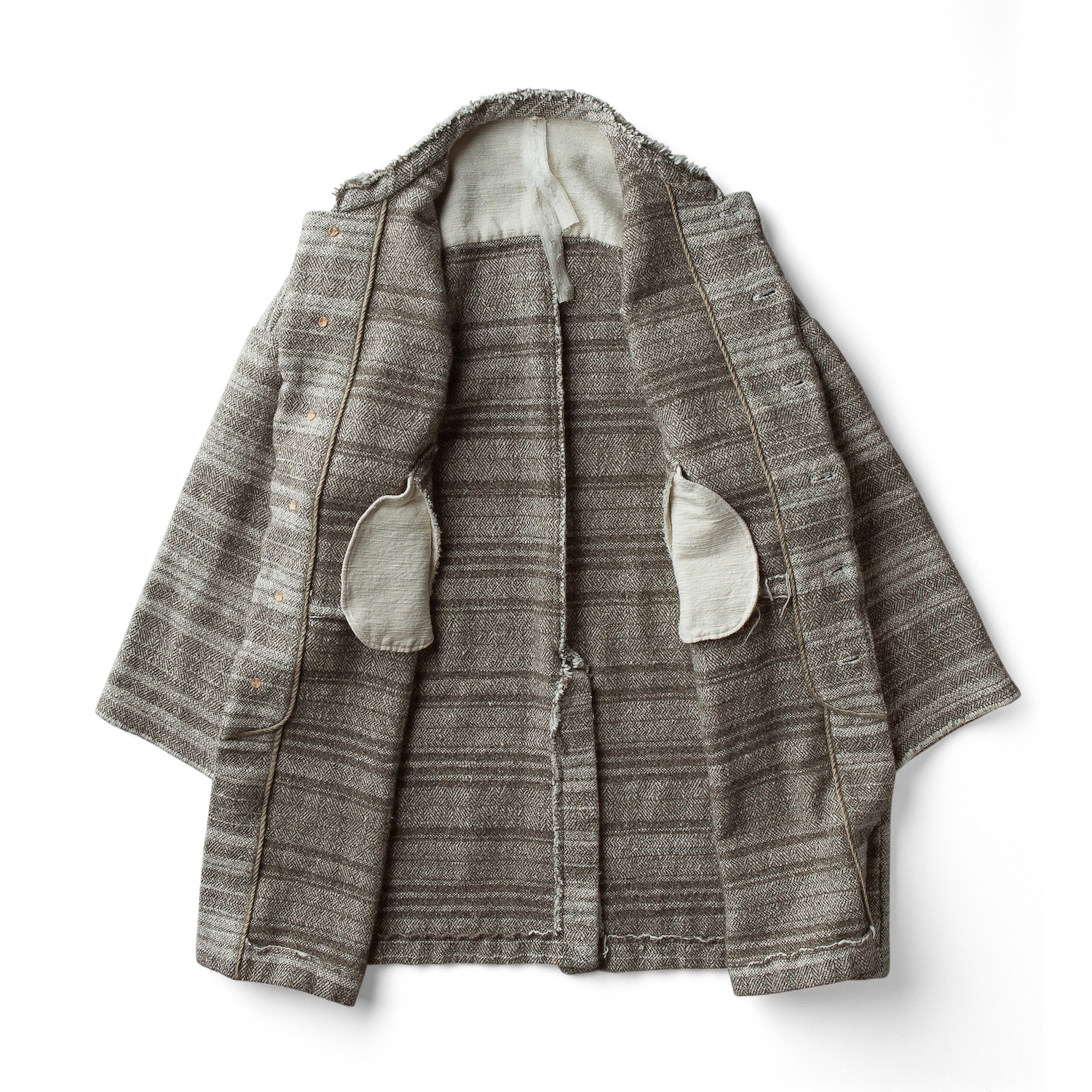
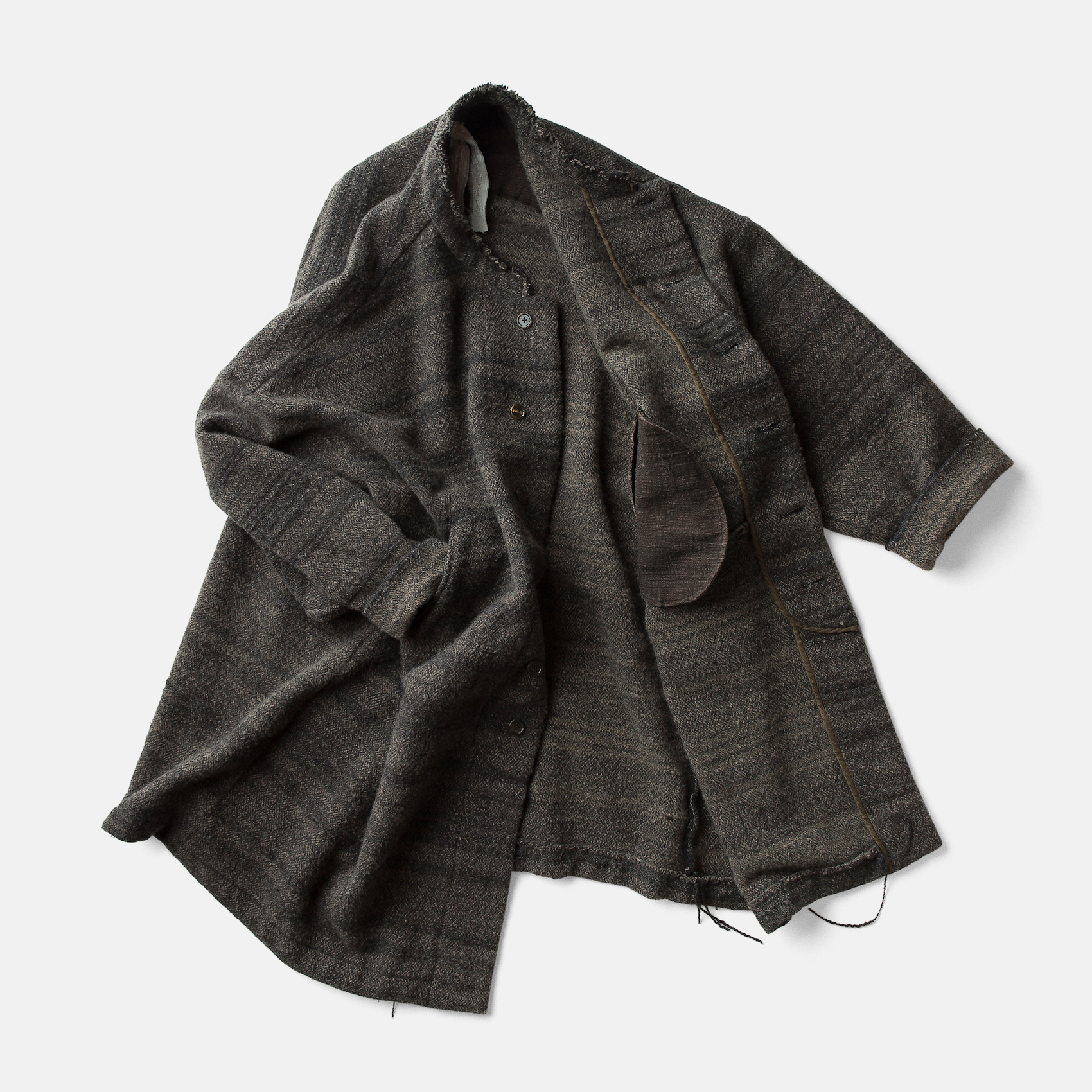
EARTH WALLの生地をふんだんに使用し、分量も持たせたBOOK ORCHESTRA COAT。
衿がカットされた設計と、フロントのダーツポケット、内側にはポケット袋布など随所に入るガラ紡。
一重の構成と、ボリュームのあるコートの構造は、EARTH WALLのムードを最高潮に演出しているもの。



総裏地のZEN JACKET。
お台場仕立ての裏地パイピング仕様は、量産型の生産システムでは、ほとんど不可能ではないかと思う。
それくらい難しい仕様ですが、ZEN JACKETは、袖のつくり肩の構造が非常に特殊。
通常とは、全く異なる地の目である。
肩部分をバイアスで使い、そのまま袖を下ろす。
この構造も、”自ら考えたものを、自らが形にする”ブランドならではのことである。
この仕様であることで、肩のアウトラインの馴染みの良さと、肩の稼働、腕のスムーズな動きを可能にし、COTTLEで考えるジャケットの着用時の見た目と、機能の両面を高い水準で形にしたものである。
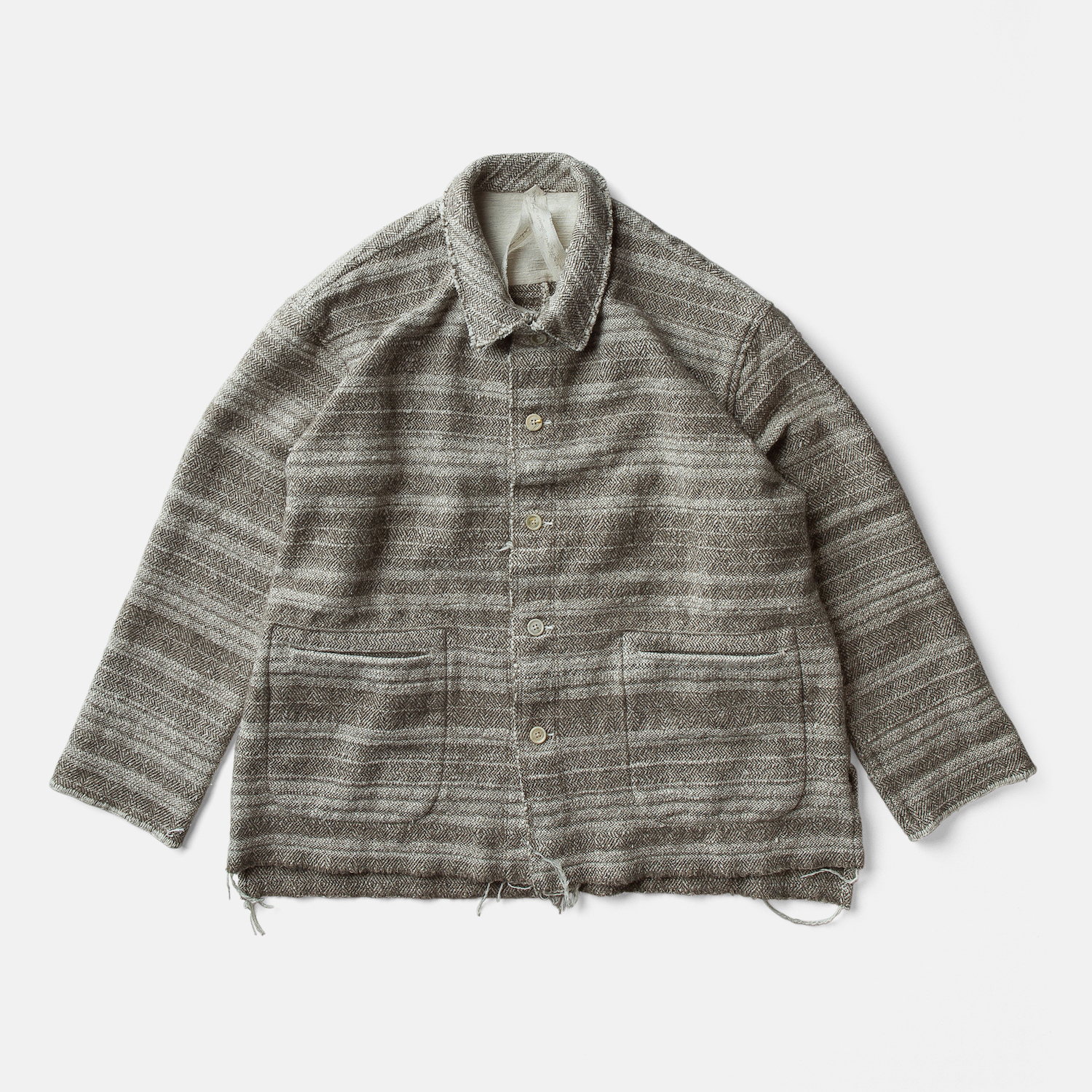
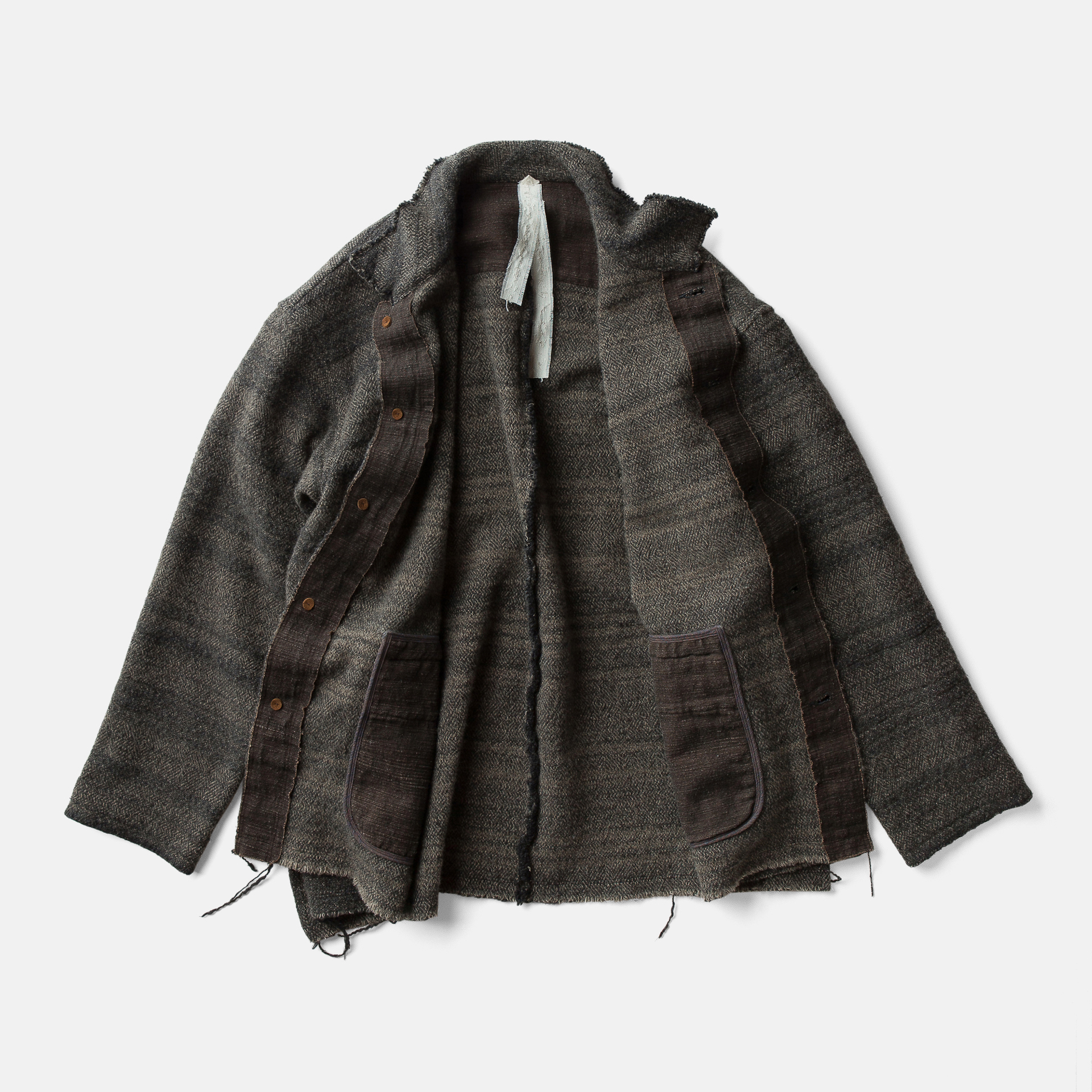
こちらは、一重でボリュームのあるCHAMPETRE BOUQUET JACKET。
前立てや、ポケットなどもガラ紡生地での切り替えで、衿や裾などは裁ち切り仕様。

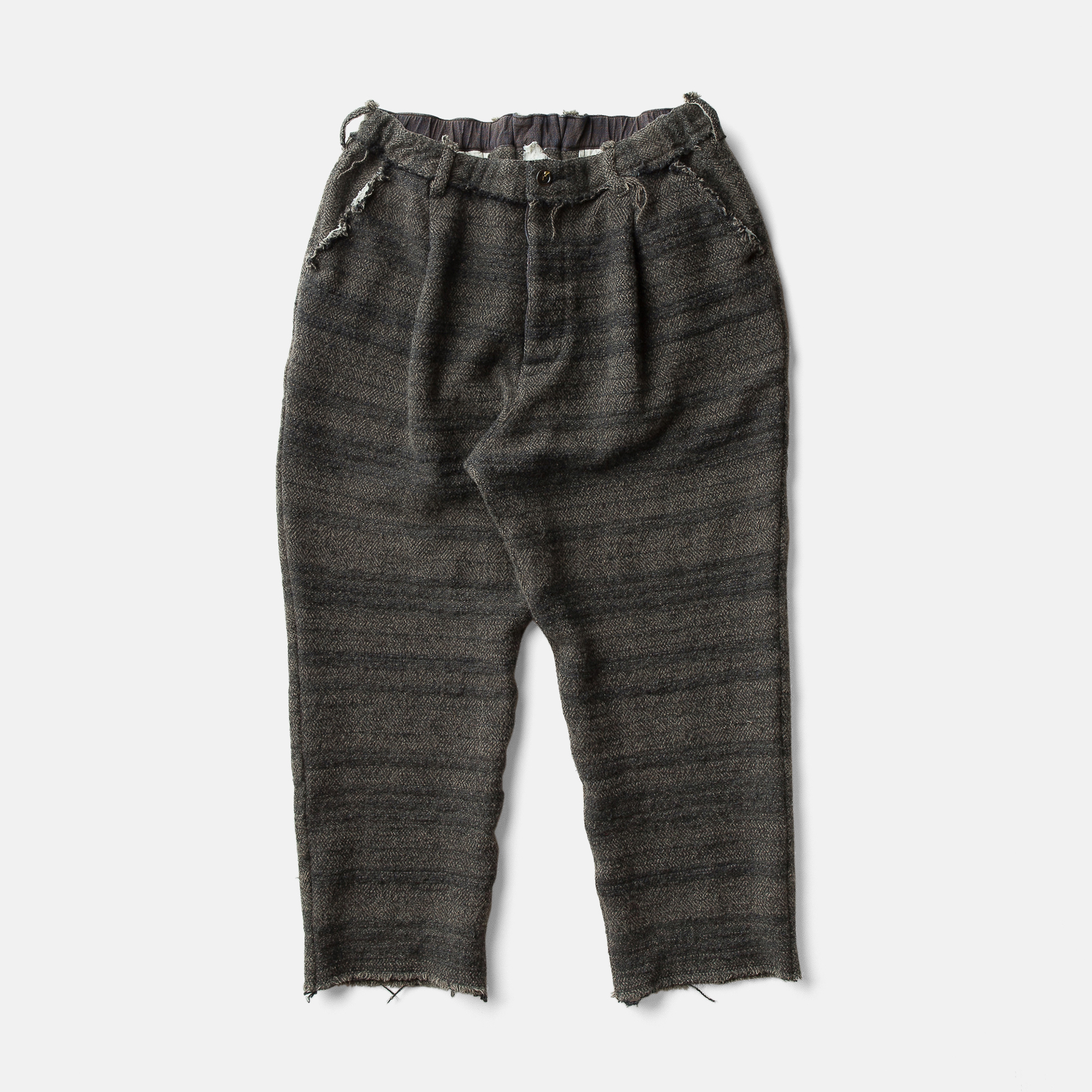
お尻周りやワタリに少し分量があり、レングスが短めに設定されたGURHKA PANTS。
こちらも一重ですが寒さは感じず、秋から冬終わりまで、衣服内部を快適に保温してくれるパンツです。
直接的に肌に当たることが多くなる分、生地の魅力をとても感じてもらうことができると思います。
他にも、、、
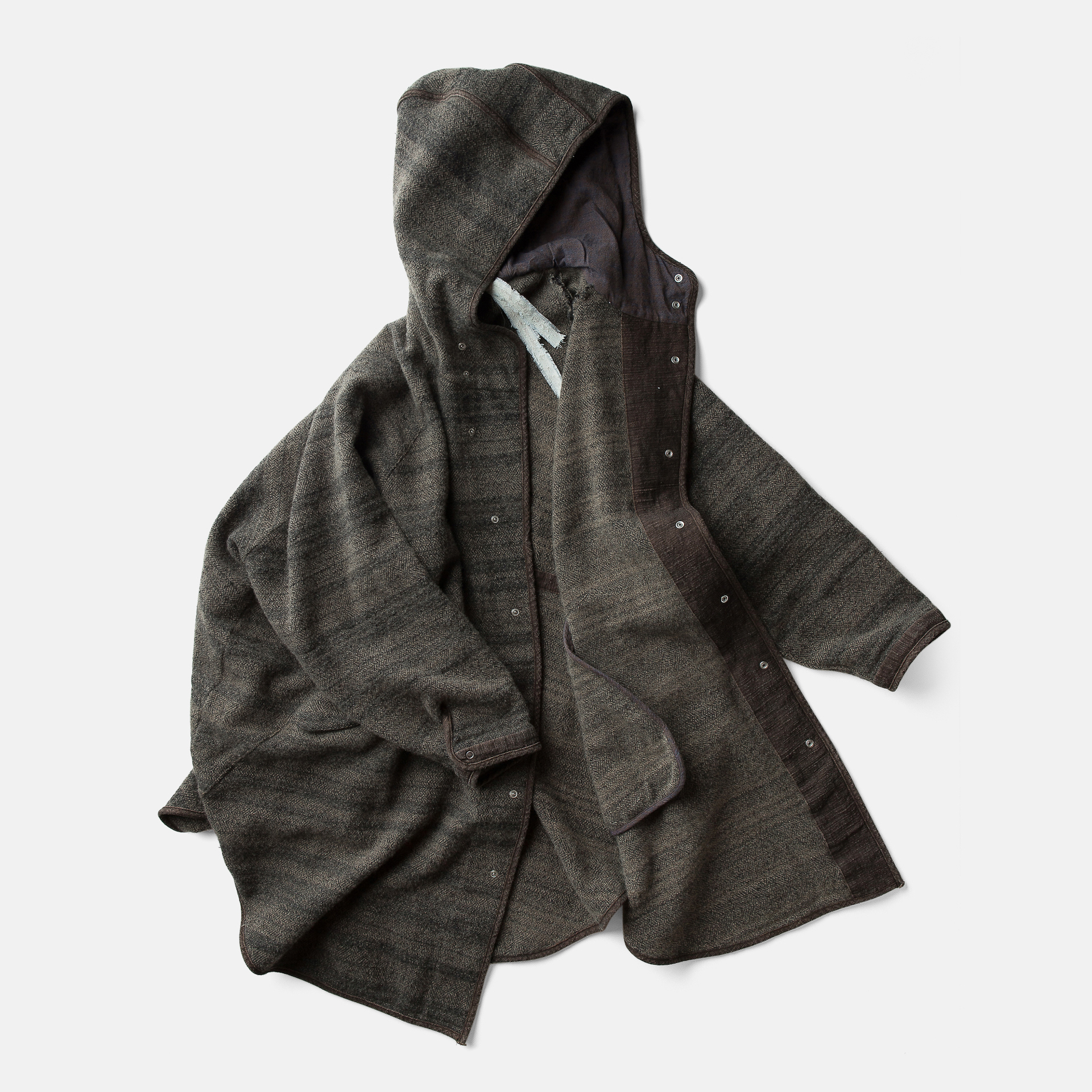
丸みのあるEGG COATや、
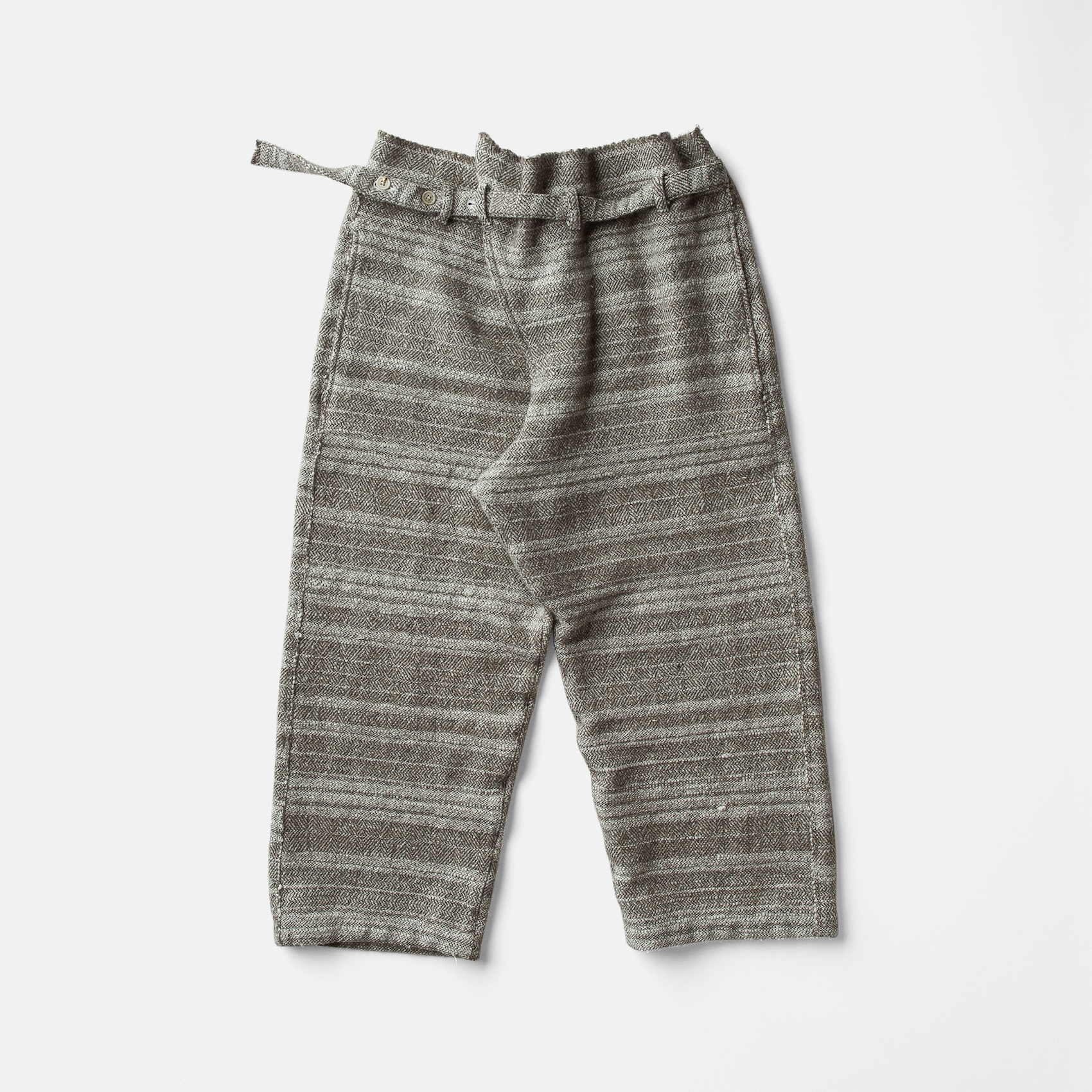
よりボリュームのあるSOUAN PANTS。
一部のみの掲載ですが、多様なスタイルが存在することもCOTTLEの特徴。
コートは、冬の装いに最適だと思いますが、皆様の生活スタイル、使用頻度が高そうな用途に合わせた洋服の形をお勧めしたいと思っています。
僕自身も、COTTLEの洋服のヘビーユーザー。
使うことを第一に考えられている耐久性はもちろんですが、手にして頂けた方が、日々使うことによって、手にした時よりもどんどん感じられることが増えていくはずです。
だから、とにかくたくさん使ってもらえそうなものを選んで頂くことが、COTTLEの場合はベストだと思っています。

見る人を惹きつけ、感性に訴えるような深い奥行きを持ったEARTH WALLの生地。
工業的につくられたフラットなものではなく、その複雑さからなる視覚的な”美しさ”。
そして、着心地の柔らかさや軽さ、適した季節での着用時の無理のない自然な保温力を持つ、という着る人の身体への優しい”機能”を持っているもの。
これこそまさに、使うための”用の美”を持った生地であり、”民藝の思想”が注がれた洋服コレクションであると思います。
期間中にお越し頂ける方は、ご覧頂けましたら幸いです。
LE BERGER / Herd Limited.
shop talk & communications by Akihiko Fukuda
__________
The English translation is as follows:
The COTTLE ORDER EXHIBITION we recently announced is now detailed on the brand’s official Instagram account as well.
The exhibition will be held over nine days, from Saturday, May 3rd to Sunday, May 11th.
Opening hours are scheduled from 11:00 AM to 5:00 PM.
However, since it falls during the long holiday period, we understand that many of you may have different plans.
If you are planning to visit and would like to come outside of the listed hours, please feel free to contact us in advance. We will do our best to accommodate you.
During the exhibition period, as it will be held at the brand’s own base, we plan to have nearly the entire COTTLE collection line available for viewing.
Today, I would also like to introduce one of the special series from the brand.
As mentioned on COTTLE’s official website, this is the entrance to their atelier.
The building, which is over 130 years old, features traditional Japanese wisdom in the form of earthen walls (tsuchikabe).
The texture draws you in — so much so that you naturally find yourself wanting to reach out and touch it.
If you visit during the exhibition period, you’ll be able to see it in person.
Regarding these earthen walls, the brand’s official website describes them as follows:
“Earthen walls, as the name suggests, are primarily made from the soil of the local land. To create swelling and texture in the walls, the soil is fermented and mixed with straw; bamboo is incorporated to strengthen the foundation and improve durability. In some cases, sand or iron powder is also added, optimizing the walls for daily life.”
These walls embody the wisdom of those who came before us. The fact that they can still be seen today in their original form speaks to the extraordinary level of craftsmanship involved.
It is from a deep reflection on these earthen walls that COTTLE developed a new collection.
“EARTH WALL”
An organic vitality that feels as if the fabric were handwoven.
This fabric can be described as a fusion of “craft” and “industrial production.”
It embodies both elements, and they are blended together at an exceptionally high level.
As I will continue to describe, “EARTH WALL” not only possesses a profoundly Japanese sense of beauty…
It also delivers “high functionality” — offering comfort, warmth during appropriate seasons, and a gentle touch on the body.
It truly represents a fabric with the “beauty of utility,” crafted with the spirit of “mingei” (folk craft philosophy) infused into it.
With that in mind, I would like to introduce this remarkable creation in today’s article, so that everyone can appreciate its excellence.
The weaving structure is extremely complex, and you can truly feel a living movement within the fabric itself.
It looks so natural that you wouldn’t doubt it if someone told you it was handwoven.
That’s how much volume and richness the threads have — the texture is so captivating, you find yourself drawn into it.
The material composition is:
- Organic Cotton 57%
- Wool 23%
- Cashmere 20%
However, this fabric is the result of the “soul” poured into it by both COTTLE and the skilled artisans who collaborate with them.
There is a unique greatness to “EARTH WALL” that cannot be understood by percentages alone.
First, this is the warp thread.
Two types of yarn — beige and dark brown — are twisted together to form a plied yarn.
The beige yarn is undyed cashmere, showcasing the natural color of the animal fiber, spun as 16-count single yarn.
In contrast,
The dark brownish yarn, as described on the official website, was inspired by the “sarunokoshikake” (a type of bracket fungus) and is an original wool color developed by COTTLE, spun as 14-count single yarn.
These single yarns are twisted together to form a plied yarn, which is then set as the warp.
Thanks to the generosity of Mr. Watanabe from COTTLE, I was able to borrow a piece of the EARTH WALL fabric to deepen my understanding and take these photos.
The color used here is “STUCCO ECRU,” which most clearly conveys the mood of EARTH WALL.
I would like to draw your attention to the warp section in the photos above, where the wool-cashmere plied yarns are used. The arrangement of the warp threads has been carefully considered, and combined with the substantial loft of the yarn itself, you can feel a remarkable density even just from the warp area.
Moreover, there is absolutely none of that prickly sensation typically associated with animal-fiber fabrics against the skin.
In my understanding, even with 100% cashmere, if it is woven (as opposed to knitted), without special attention to the yarn, weaving method, and finishing, a prickly feeling is almost unavoidable. However, with COTTLE’s warp yarns, there is no need to worry at all.
Next, the weft.
While the weft yarn is cotton, it is no ordinary cotton yarn.
It is made using the “Gara spinning” method.
This spinning technique was invented in Japan during the Meiji era and is considered highly original compared to other spinning technologies.
In general, cotton spinning methods developed in America or Britain have become the mainstream even today.
Cotton yarn produced through Gara spinning is vastly different from the industrially uniform appearance of conventional yarns — it embodies the beautiful “handwork” aesthetic that COTTLE values, full of character and nuance.
Within a single cotton yarn, the fullness and tension vary, and as the yarn thickens and thins, the spinning speed also fluctuates — sometimes faster, sometimes slower.
Furthermore, when the yarn breaks during the Gara spinning process, it must be manually twisted back together, much like making a paper string.
COTTLE has been researching this Gara spinning technique since the early days of the brand, and has refined it to the point where it is now used in the EARTH WALL fabric.
The yarn preserves the natural loft and softness of cotton fibers to the maximum, allowing one to literally feel the high quality of “traditional handcraftsmanship” in its texture.
However, there is a major challenge: “Gara-spun yarn alone cannot be loaded into a loom.”
To address this, a fine cotton thread called “kabe-ito” (wall thread) is wrapped around the Gara yarn, making it possible to weave.
Personally, I have pursued a variety of high-quality cottons — such as Suvin Gold Supreme and Ultimate Pima — but when I first encountered the texture of Gara-spun yarn, I was astonished by its unparalleled airiness and superior quality.
Of course, it depends on the desired direction of the material, but the reason I had never encountered such yarn outside of COTTLE is exactly because of the factors mentioned above.
Though it is a highly labor-intensive process with many steps to prepare it for weaving — resulting in a very costly cotton yarn — the beauty and incredibly soft texture of this yarn are truly irreplaceable.
Warp and weft with completely different expressions and characteristics.
Black, gray, brown, the undyed natural color of animal hair, and ‘Soil Brown’—a dark tone with a distinct hue.
The “STUCCO ECRU” fabric I introduced earlier—
it is a material that, much like an earthen wall, instinctively draws the eye and invites you to reach out and touch it.
I truly hope you will experience it in person.
However…
The real reason why I was so astonished by this fabric lies beyond its appearance.
As I mentioned at the beginning, it embodies the “beauty of utility” (“Yō no Bi”).
Allow me to explain that in my own way from here.
First, most garments made from EARTH WALL fabric are unlined.
Even though the weight and texture of the material make it seem best suited for autumn and winter, almost all pieces are designed with a single layer.
There are pants in the collection as well, and even those are unlined.
Yet, I have repeatedly heard from people who wear EARTH WALL pants that,
“Even with a single layer, cold winds don’t penetrate, and they feel warm and incredibly comfortable.”
Imagine this:
Typically, fabrics woven with thick yarns have large gaps between the threads.
Even if they look warm, they can be disappointingly cold because the wind passes through them.
Moreover, fabrics made of slightly fuzzy wools or other animal hair textiles often cause unpleasant itching sensations when worn directly against the skin.
However, COTTLE’s EARTH WALL fabric has achieved an extraordinary realm that overcomes all of these issues.
By using Gara spinning, the fabric becomes exceptionally airy.
Moreover, by applying both fabric washing and garment washing processes, the natural fullness of the material is fully brought out.
As a result, the garments are incredibly light and offer a soft sensation that gently rests on the body when worn.
This photo shows the reverse side—the side that touches the skin.
Without a lining, the soft fullness of the material naturally wraps around the body.
On the surface, the Gara-spun cotton appears prominently, with the rich texture creating a landscape of undulations that traps ample air, forming a warm layer.
On the inside, the gentle, comforting fiber characteristics of wool and cashmere are fully expressed.
And furthermore, here—
A few years ago, I learned about this measuring device for checking fabric thickness from Kaneta Orimono.
The thickness of the EARTH WALL fabric measures 1.95 millimeters.
This measurement was taken at a section where the Gara-spun weft yarn is thinner…
The measurement taken at a section where the weft yarn is thicker was 2.68 millimeters.
This figure is truly astonishing.
Typically, even for robust winter fabrics like melton or tweed, the thickness is around 1.1 millimeters.
Also, for those who own other pieces from COTTLE’s collection, you may already know that the “LEAF VEIN” fabric is thicker compared to standard shirt fabrics.
The “LEAF VEIN” fabric measures 0.41 millimeters in thickness.
This thickness positions it between that of a typical shirt fabric and an autumn-winter jacket fabric.
Additionally, COTTLE’s 11.3oz denim measures 0.81 millimeters in thickness.
Typically, denim around 11oz would have a standard thickness of approximately 0.65 millimeters, but COTTLE’s fabric, with its plump and airy yarns, shows greater fullness compared to the general standard.
For comparison, when I measured my wife’s shirt, it was 0.24 millimeters thick…
It’s a typical mass-produced 100% cotton shirting fabric, but the result is completely different.
Incidentally, banknotes are apparently made to be around 0.1 millimeters thick.
From these observations, it’s clear that COTTLE’s fabrics have a strong yarn loft and substantial fabric thickness.
Among them, EARTH WALL shows more than twice the thickness compared to general industrially produced melton fabrics.
And it’s not just about the thickness of the fabric…
To observe the fabric’s density from the reverse side, I photographed it under natural light.
You can see the scenery of a rural landscape with an unmanned station in the background.
When you hold the fabric up to natural light like this, you can see that very little light passes through — the gaps are extremely small.
Of course, with fabrics woven from thick yarns, this is somewhat expected. However, even with fabrics made from thinner yarns, in general, you would find larger and more numerous gaps where light shines through. (Except for fabrics intentionally designed with larger gaps.)
The more mass-produced the fabric is, the more common these large gaps become. Additionally, cheaper fabrics often have uneven textures, causing inconsistent light transmission.
In contrast, EARTH WALL fabric boasts both a tightly packed weave and an incredibly fine, even texture.
This ensures that cold air cannot easily penetrate, while also offering excellent durability.
Even though it uses thick garabou yarns, the tiny, uniform gaps between the threads are truly extraordinary.
EARTH WALL possesses not only this remarkable “fabric thickness” and “density,”
but also…
Despite its substantial thickness and density,
it remains remarkably supple and soft, gently conforming to the body.
Thus, even for unlined garments, or jackets with linings, the silhouette never looks awkward or bulky when worn.
Normally, a fabric thicker than 2mm with such high density would be stiff, heavy, and would cause the garment’s form to puff out excessively when worn.
But COTTLE has completely avoided these issues.
The way a garment looks when worn is treated as an extremely important consideration.
Moreover, the feeling of wearing EARTH WALL fabric could be described as:
“Like being wrapped in an incredibly soft, body-hugging blanket — so comfortable that it might make you sigh with delight.”
The ‘Kintsugi’ button, imbued with the brand’s philosophy.
In some pieces, “Hige Tsumugi” fabric is used for finishing the edges of the inner pocket lining.
Since COTTLE garments are produced one by one in their in-house atelier, not only the exterior but also the interior details and sewing specifications are crafted with exceptional care.
Below, I will introduce several models.
The BOOK ORCHESTRA COAT generously uses EARTH WALL fabric, giving it a substantial volume.
With a collar designed to be cut away, front dart pockets, and Gara-bou fabric incorporated into areas such as the inner pocket linings, every detail is thoughtfully crafted.
The unlined construction and voluminous structure of the coat elevate the mood and character of the EARTH WALL fabric to its highest expression.
The fully lined ZEN JACKET.
The “Odaiba” tailored lining with piping is a construction so intricate that it would be almost impossible within a mass production system.
That’s how challenging the specification is, yet the ZEN JACKET also features a highly unique shoulder and sleeve structure.
The fabric grain is completely different from the standard approach: the shoulder section is cut on the bias, and the sleeve extends directly downward from there.
This construction is something only a brand that “conceives and realizes its own ideas” could achieve.
Thanks to this method, the jacket offers an exceptionally natural shoulder outline, excellent shoulder mobility, and smooth arm movement — achieving both the visual presence and functionality that COTTLE envisions at a very high level.
This is the unlined, voluminous CHAMPETRE BOUQUET JACKET.
The front placket and pockets are accented with panels of Garabou fabric, while the collar and hem are finished with raw-cut edges.
The GURKHA PANTS are designed with a slightly more generous fit around the hips and thighs and a shorter length.
Although they are unlined, they provide excellent warmth, making them ideal for wear from autumn through the end of winter.
Because the fabric often comes into direct contact with the skin, you can truly appreciate the exceptional texture and comfort of the material.
Additionally…
The rounded EGG COAT,
and the more voluminous SOUAN PANTS,
are also part of the lineup.
This is just a small selection, but one of COTTLE’s characteristics is the diversity of styles they offer.
While the coats are perfect for winter outfits, I hope to recommend pieces that best match each person’s lifestyle and frequency of use.
I myself am a heavy user of COTTLE’s garments.
Their outstanding durability is a given, but more importantly, the more you use them daily, the more deeply you’ll come to appreciate their qualities over time.
That’s why, with COTTLE, I believe it’s best to choose pieces you’ll use frequently and wholeheartedly.
The EARTH WALL fabric draws the viewer in, touching the senses with its profound depth.
It is not an industrially flat fabric, but one born from complexity, offering a visual “beauty” that resonates on a deeper level.
At the same time, it provides a soft, lightweight feel and gentle, natural warmth during the appropriate seasons — combining beauty and functionality for the wearer.
This is truly fabric embodying the “beauty of utility,” infused with the spirit of Mingei (folk craft philosophy).
If you have the chance to visit during the exhibition period, we would be delighted for you to experience it firsthand.

